COOKIES AND BISCUITS
TOCANTINS CRACKNEL (Amor-perfeito)
 40 servings
40 servings
 25 minutes
25 minutes
 Easy
Easy
• 1 KG MANIOC STARCH
• 2 TEACUPS SUGAR
• 1¼ TEACUPS BUTTER
• 1 PINCH SALT
• 1 TEACUP COCONUT MILK
Mix the ingredients one by one and stir vigorously. Add the coconut milk last, so the batter won't stick to your hands and will be at the right consistency. To make each cracknel, roll them into a ball, flatten and make a cross shaped cut. This cut is what will give shape to the cracknel. Bake the biscuits in a preheated oven at 220°C for 15 minutes. When it is golden, remove from the oven.
IN DETAIL
This specific kind of cracknel comes from Natividade, in Tocantins, where the community has been keeping the recipe alive for over 100 years. But where did it come from? The Portuguese were the ones who introduced the amor-perfeito when they landed in the region during the 18th century.
GUAVA JAM COOKIES (Beijo-de-freira)
 40 units
40 units
 40 minutes
40 minutes
 Easy
Easy
• 3 SIFTED YOLKS
• 6 TABLESPOONS SUGAR
• 500 G BUTTER
• 1 TABLESPOON BAKING POWDER
• 10 DROPS VANILLA EXTRACT
• 500 G CORNSTARCH
• 1 TEACUP ALL-PURPOSE FLOUR
• ½ TEACUP GRANULATED SUGAR, FOR GARNISHING
FILLING
• 500 G SOFTENED GOIABADA (GUAVA JAM)
Combine the yolks, sugar, and butter. Add the other ingredients, kneading until the dough can be handled. Grease a baking tray with butter and sprinkle it with all-purpose flour. Roll into small balls and bake in a preheated oven at 180°C for about 20 minutes, or until their bottoms are golden. After they cool, stick two pieces of cookie together with the goiabada (or whichever jam you prefer) and garnish it with sprinkled granulated sugar.
IN DETAIL
This sweet with a provocative name ("Nun kisses") appeared at the Santa Clara do Porto Convent and arrived in Brazil during the 17th century, possibly by the hands of nuns from the Order of Saint Clare. The original recipe, which used almonds, was adapted until it arrived at the present form.
DULCE DE LECHE CAKES (Bem-casado)

 16 units
16 units
 2h30
2h30
 Medium
Medium
• 6 LARGE EGGS
• ½ TEACUP PLUS ¾ TEACUP OF SUGAR
• ½ TEACUP ALL-PURPOSE FLOUR
• 1 SHALLOW TABLESPOON BAKING POWDER
• 1½ TEACUPS CREAMY DULCE DE LECHE
Using a beater, whip the eggs and ½ teacup of sugar until obtaining a light and yellowish cream. Add the sifted flour and baking powder, mixing gently. Transfer to a greased tin and bake in a preheated oven at 160°C for about 25 minutes, until golden. Remove from the oven and allow to cool. Remove from the tin and cut portions of bem-casado with a round or square cutter. Cut those in half and fill with the dulce de leche. For the frosting, make a syrup with ¾ teacup of sugar and ½ teacup of water. Carefully coat the bem-casados. Another way to do it is to bake them individually, by putting the batter into a pastry bag and making small bunches on a baking paper or silicon mat.
IN DETAIL
During colonial times, in Northern Portugal, treats called "casadinhos" were popular - the name, literally "married", refers to their two parts, which are glued together with a pasty sweet. But the bem-casado found in Brazilian wedding receptions is Brazilian through and through. The custom of wrapping them in crepe paper, tulle, and ribbons seems to have appeared in doll christening games played in the country side of Minas Gerais and São Paulo.
HOMEMADE COOKIES (Biscoito caseiro)
 10 to 15 servings
10 to 15 servings
 30 minutes, plus time to rest
30 minutes, plus time to rest
 Easy
Easy
• 1¼ TEACUPS ALL-PURPOSE FLOUR
• ½ TEACUP POWDERED SUGAR
• ¾ TEACUP COLD BUTTER, CUT INTO CUBES
• 1 EGG
• 1 PINCH SALT
Sift the flour, salt and sugar mixed together. Cut the cold butter into small cubes and return them to the fridge for 10 minutes. Place the butter on top the flour mixture so the little pieces won't stick to one another. Mix them with your fingertips as fast as you can, until you obtain a crumbly dough. Add the eggs and knead gently until the dough is formed. If the dough isn't coming together, add a bit of ice-cold water. Roll up the dough into a ball, wrap it with a plastic film and flatten it so it will be easier to roll out later. Allow it to rest in the fridge for at least 1 hour, or up to 48 hours. When you choose to use it, roll it out in a surface sprinkled with a bit of flour until you have a 1 cm thickness. Cut it into rectangles or another shape. Bake in a preheated oven at 180°C for 12 minutes, or until lightly golden.
LADYFINGER BISCUITS (Biscoito champanhe)
 48 units
48 units
 40 minutes
40 minutes
 Medium
Medium
• 4 EGGS
• 135 G SUGAR
• 110 G ALL-PURPOSE FLOUR
• ½ TEASPOON BAKING POWDER
Preheat the oven at 200°C. Line two baking trays of approximately 30 cm X 45 cm with baking paper. Whip the egg whites until they form soft peaks. Little by little, add 2 tablespoons of sugar and continue to whip until forming stiff peaks. In another bowl, whip the remaining sugar with the yolks until obtaining a light-coloured cream. Sift the flour and baking powder. Put half of the whipped egg whites into the bowl with the sugar and yolks cream. Stir. Add the flour and the remaining half of the egg whites. Stir again. Put the cream into a pastry bag with a round and smooth end. Squeeze it and arrange the ladyfingers on top of the baking paper. Bake for 14 minutes.
IN DETAIL
The basis for the pavê (a type of trifle), a popular Christmas dessert, the ladyfinger biscuit comes from the Northern Italy region known as "Duchy of Savoy" in the 15th century. It was prepared for the official reception for the French king and it was called, in Italian, "savoiardi". It spread out to Europe and, in Portugal, was known as "palito de Reine", or "biscoito de champanhe", such as we know it here.
ARROWROOT BISCUITS (Biscoito de araruta)
 40 units
40 units
 1h10
1h10
 Easy
Easy
• 1 TEACUP ARROWROOT OR MANIOC STARCH
• 1 TEACUP ALL-PURPOSE FLOUR
• 1 EGG WHITE
• 3 YOLKS
• 1 TEACUP SUGAR
• 1 TEACUP BUTTER
Sift the arrowroot (or manioc starch) with the flour. Set aside. Whip the egg whites until firm. Combine the yolks and the sugar. Add the whipped egg whites and the butter to the yolks and sugar mixture. Whip vigorously to combine the ingredients. Add the flours and whip. If it is too soft, add a bit more of arrowroot. Roll out the dough in a surfaced with sprinkled flour and cut the biscuits with cookie-cutter, using whichever shape you wish. Bake in a preheated oven for 20 minutes on a greased and floured baking tray.
GOMA BISCUITS (Biscoito de goma)
 1 kg
1 kg
 20 minutes
20 minutes
 Easy
Easy
• 4½ TEACUPS MANIOC STARCH
• 4 YOLKS
• 2 TABLESPOONS BUTTER
• 1 TEACUP SUGAR
• 1 PINCH SALT
Combine all the ingredients. Remove little pieces of the dough, roll them in the palm or you hand and press down on them with a fork. Put the biscuits on a greased baking tray and bake at 170°C for 12 minutes. Be careful not to brown them.
CREAM BISCUITS (Biscoito de nata)

 30 units
30 units
 1 hour
1 hour
 Medium
Medium
• 3 TABLESPOONS SUGAR
• 1 TABLESPOON BUTTER
• 2 YOLKS
• 190 ML NATA (DOUBLE CREAM)
• 1 COFFEE SPOON SALT
• AS MUCH CORNSTARCH AS NEEDED
Whip the sugar with the butter. Add the yolks while continuously whipping. Put in the nata and the salt; mix until smooth. Little by little, add the cornstarch until the dough no longer sticks to your hands. Roll it out with a rolling pin and cut into the desired shape. Bake in a greased baking tray at 160°C until firm, without allowing it to brown. Wait until it cools and serve.
MANIOC STARCH BISCUITS (Biscoito de polvilho)
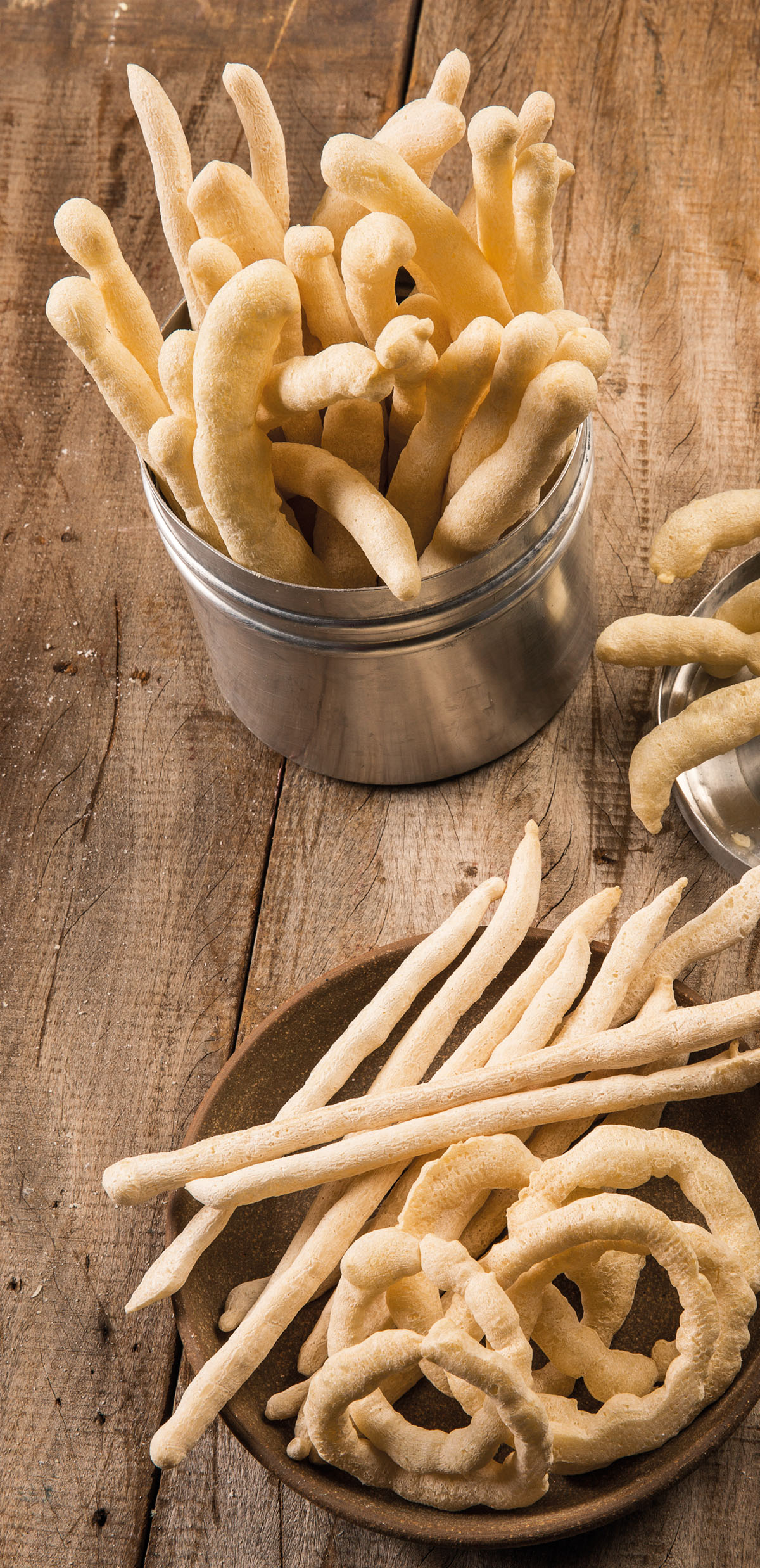
 40 units
40 units
 1 hour
1 hour
 Medium
Medium
• 1 TEACUP CORN OIL
• ½ TEACUP MILK
• 1¾ MANIOC STARCH
• 2 TABLESPOONS SUGAR
• 2 EGGS
• 1 COFFEE SPOON SALT
Heat up 2 teacups of water, oil, and milk until they boil. Blanche the manioc starch and the sugar, stirring constantly so they won't form lumps. When the dough is no longer hot, add the eggs and salt; stir vigorously. Put in a pastry bag and squeeze out line over a silicon mat or baking paper. Bake at 180°C for 8 minutes, or until firm and golden. Allow it to cool and serve.
BUTTERY COOKIES (Bolacha amanteigada)
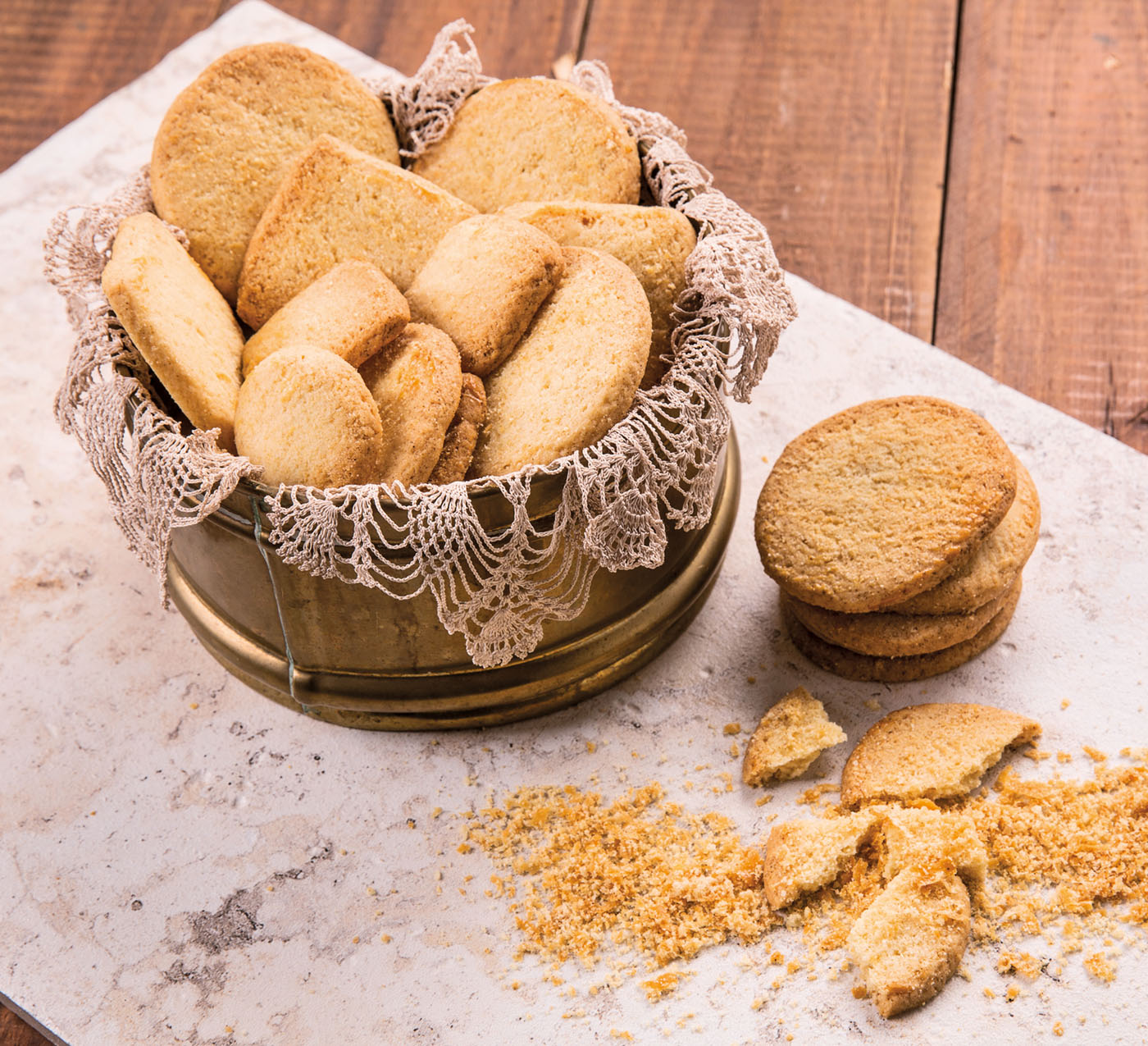
 8 servings
8 servings
 1h20
1h20
 Easy
Easy
• 100 G UNSALTED BUTTER AT ROOM TEMPERATURE
• ½ TEACUP SUGAR
• 1 EGG
• 1 PINCH SALT
• ZESTS OF ½ A LIME
• ½ TEACUP ALL-PURPOSE FLOUR
• 1½ TEACUPS CORNSTARCH
• 250 G CREAMY GOIABADA (GUAVA JAM)
• MELTED BUTTER, FOR BRUSHING
• GRANULATED OR REFINED SUGAR
With a spatula, combine the butter with the sugar until smooth. Add the egg, salt, and lime zests. Stir until smooth. Put in the flour and cornstarch, after sifting them together. Arrange the dough between two pieces of baking paper and roll them out with a rolling pin until it is about 0.5 cm thick. Set aside in the fridge for 2 hours. With a round cookie-cutter, cut several slices of dough. Put then in a baking tray lined with baking paper and put them in the freezer for 20 to 30 minutes. Preheat the oven at 160˚C and bake the cookies for 10 to 15 minutes. Do not allow them to turn golden; remove from the oven while still white. As soon as they cool down, put them together with the creamy goiabada, brush with the melted butter, and coat them with sugar.
CHIPA

 20 units
20 units
 45 minutes
45 minutes
 Medium
Medium
• 3⅓ TEACUPS MANIOC STARCH
• 3 CUPS MEIA-CURA CHEESE
• ½ STICK BUTTER AT ROOM TEMPERATURE
• 3 EGGS
• 1 TEACUP WHOLE MILK
• ½ TABLESPOON SALT
Combine the manioc starch, meia-cura cheese, butter, salt, and eggs, one by one. After mixing, slowly add the milk and stir until the dough is smooth, easy to work with and no longer sticks to your hands. Grease a baking tray with butter, make small, horseshoe-shaped rolls and bake in a preheated oven at 180°C for about 12 minutes, or until golden.
GUAVA TREATS (Goiabinha)

 4 servings
4 servings
 1 hour
1 hour
 Medium
Medium
• 2 TEACUPS ALL-PURPOSE FLOUR
• 1 TEACUP SUGAR
• ¾ STICK BUTTER
• GOIABADA CASCÃO CUT INTO STRIPS, FOR THE FILLING
• 1 PINCH SALT
Combine the flour, sugar, and butter, forming a crumbly dough. Slowly add water and knead until the dough is soft and even. Roll out the dough with a rolling pin, cut circles with 5 to 6 cm of diameter and place a strip of goiabada at the center. Fold and bake in a preheated oven at 160°C for 20 minutes, or until lightly golden. You can sprinkle it with granulated sugar, if you wish, and serve.
CRACKNEL (Sequilho)
 40 servings
40 servings
 25 minutes
25 minutes
 Easy
Easy
• 500 G CORNSTARCH
• 1 TEACUP SUGAR
• 250 G BUTTER
• 2 YOLKS
Put half of the cornstarch in a bowl. Add the sugar, butter, and yolks and stir. Slowly add the remaining cornstarch until reaching the right consistency - an even dough that does not stick to the hands. Take small portions of the dough and roll them into balls. Put them in a baking tray greased with butter or lined with baking paper. Mark the balls, pressing down on them with a fork. Bake in an oven at 180°C for 10 to 15 minutes. Remove when the bottom is golden (their top should remain light). Allow to cool and remove from the tray.
MERINGUES (Suspiro)
 20 servings
20 servings
 20 minutes
20 minutes
 Medium
Medium
• 2 EGG WHITES
• ½ CUP SUGAR
• ½ TEASPOON LIME ZEST
• 2 DROPS LIME JUICE
Mix the egg whites with the sugar and warm in a water bath until the sugar dissolves. Mix in the zest and lime juice. Beat with an electric whisk until firm. Transfer to a confectioner’s bag and shape small mounds on a baking sheet lined with parchment paper. Bake for 1 hour – or until firm – in a 100°C oven. Leave to cool inside the oven and transfer to an airtight container.
TARECO
 20 servings
20 servings
 15 minutes
15 minutes
 Easy
Easy
• ½ TEACUP MILK
• 140 G SUGAR
• 1 EGG
• 1 SHALLOW TABLESPOON BAKING POWDER
• 4 TABLESPOONS BUTTER
• ½ TEACUP ALL-PURPOSE FLOUR
• 1 PINCH SALT
Stir the ingredients with a spoon until obtaining a smooth dough. While using the spoon, shape thin flat discs and lay them on a greased tray. Bake in a preheated oven at 170°C for 8 minutes, or until golden.
CAKES AND DUMPLINGS
BELÉU
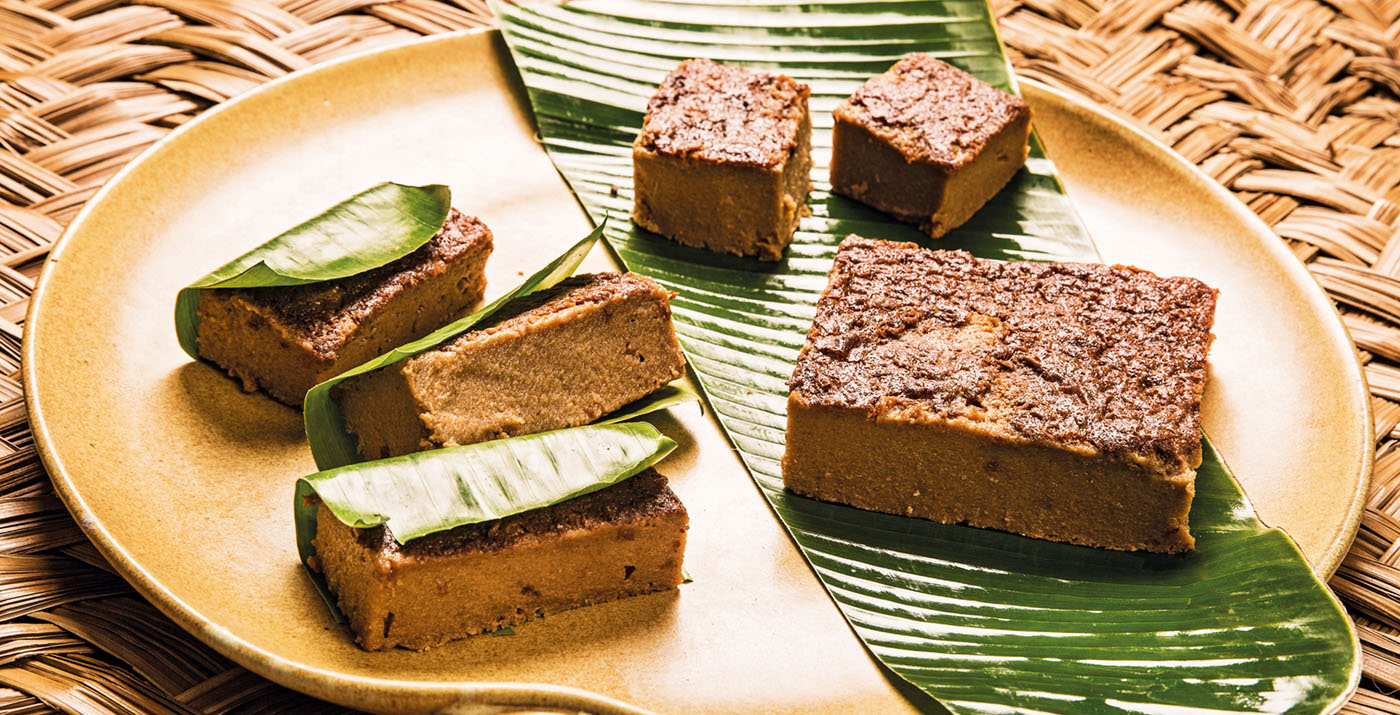
 1 rectangular baking pan
1 rectangular baking pan
 40 minutes
40 minutes
 Easy
Easy
• 1½ TEACUPS RAW, GRATED MANIOC, PEELED
• ½ TEACUP BROWN OR GRAMIXÓ SUGAR
• 1 TEACUP COCONUT MILK
• ½ TEACUP WHOLE MILK
• 3 EGGS
• 3 TABLESPOONS BUTTER
• 1 TABLESPOON BAKING POWDER
• ALL-PURPOSE OR RICE FLOUR, TO COAT THE BAKING TRAY
Combine all the ingredients, except for the baking powder, and mix them in a blender until smooth. Add the baking powder, mixing it into the dough. Grease a baking pan with butter and all-purpose or rice flour, pour in the dough and bake in a preheated oven at 180°C for about 30 minutes, or until golden.
IN DETAIL
This popular cake found on the tables and fairs of Acre state uses gramixó, a kind of brown sugar. In the North region, this type of sugar is very similar to rapadura, although not as firm. I've watched the gramixó making process in a community in Juruá, one of the Amazon's tributary rivers. By means of a hoe, the sugar slowly reaches a unique, rustic texture, that is reminiscing of a grated or pressed rapadura.
ROLLED DOUGHNUTS (Bolinho de chuva)
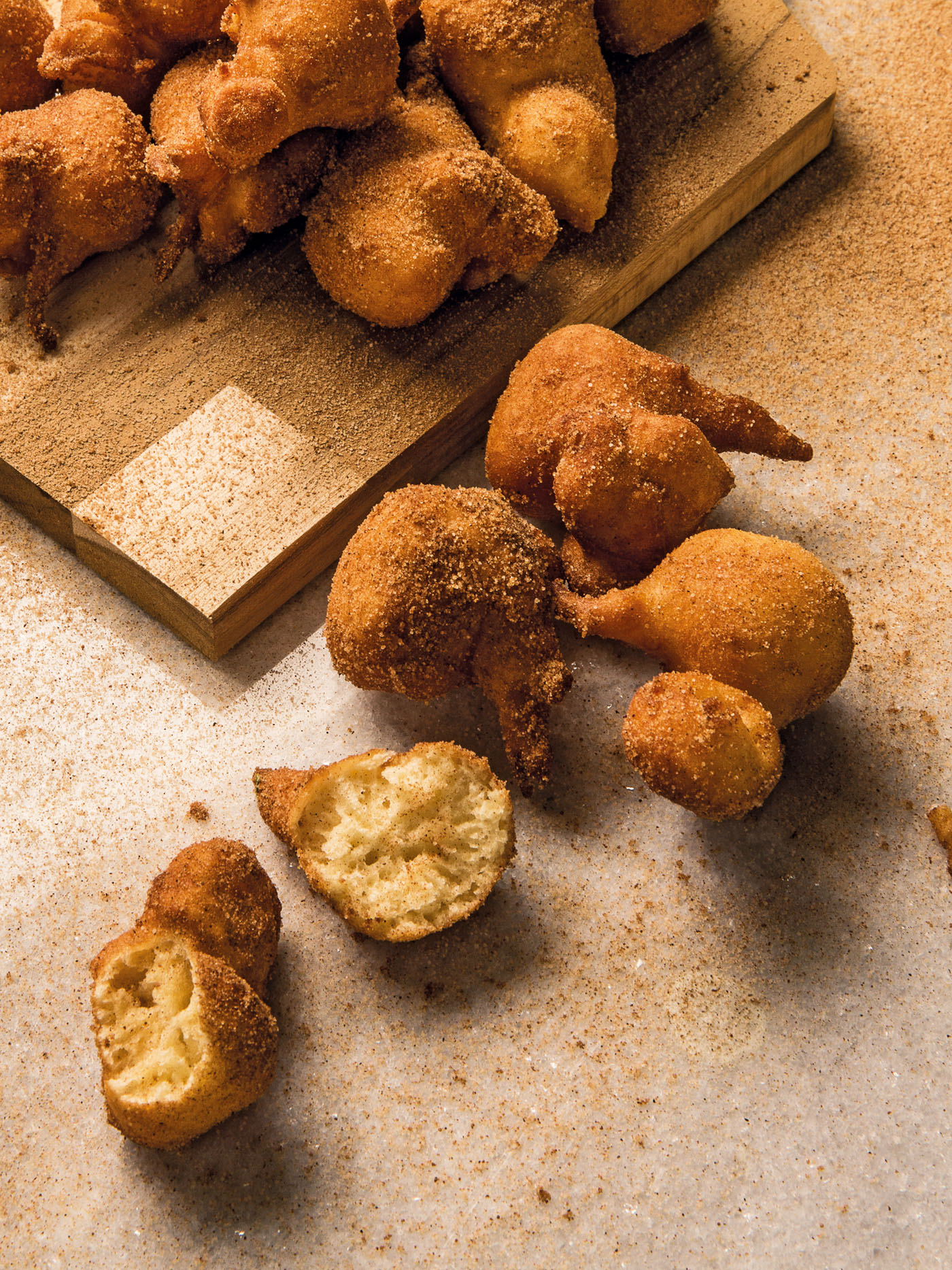
 30 units
30 units
 35 minutes
35 minutes
 Easy
Easy
• 3 TEACUPS ALL-PURPOSE FLOUR
• 2 TABLESPOONS SUGAR
• 1 TABLESPOON BAKING POWDER
• 2 TABLESPOONS BUTTER
• 1 TEACUP MILK
• 1 EGG
• ½ COFFEE SPOON OF SALT
• CORN OIL, FOR FRYING
• SUGAR AND CINNAMON, FOR COATING
Combine all the ingredients, except for the milk and egg. After you've obtained a crumbly dough, add the milk and egg. Allow the dough to rest for 15 minutes. Heat up the oil and fry spoonfuls of dough. When it is golden, remove and leave it to drain on a paper towel. Coat with sugar and cinnamon and serve.
IN DETAIL
This simple mixture produces a small dumpling that, to many people, is reminiscing of the sweet taste of childhood days. It's easily found in bakeries and many homes.
STUDENT’S DOUGHNUT (Bolinho de estudante)
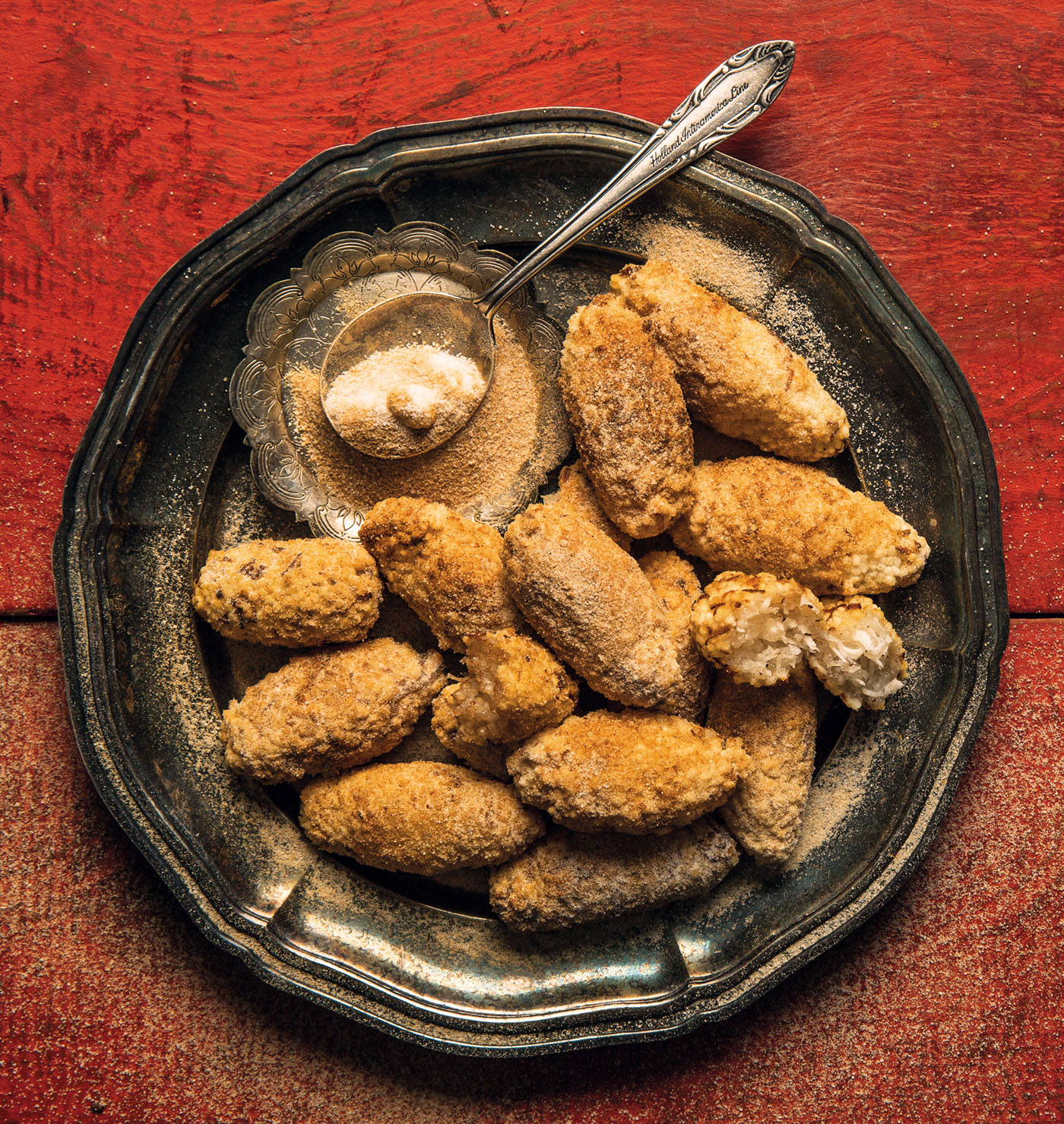
 20 units
20 units
 40 minutes
40 minutes
 Easy/Medium
Easy/Medium
• 2 TEACUPS GRANULATED TAPIOCA, PLUS A BIT EXTRA FOR COATING THE CAKES
• ¾ TEACUP SUGAR
• 1 PINCH SALT
• 2 TEACUPS COCONUT MILK
• CORN OIL, FOR FRYING
• SUGAR AND CINNAMON, FOR SPRINKLING
Combine the tapioca, sugar, and salt; hydrate with coconut milk and stir thoroughly. Allow it to rest for 20 minutes, or until the tapioca has soaked up the liquid. Roll up the cakes, shaping them like a croquette, with a tip at the ends. Coat them with granulated tapioca and fry them in hot oil, until golden. Wait until they cool for a bit, and sprinkle with sugar and cinnamon before serving.
IN DETAIL
One of writer Jorge Amado's favourite treats, who referred to it by a name that is more popular in Bahia: "punhetinha". It can be found at homes or being sold by female street vendors (baianas), next to other staples of Bahia's cuisine.
BAETA CAKE (Bolo baeta)
 8 servings
8 servings
 1 hour and 40 minutes
1 hour and 40 minutes
 Easy
Easy
• 1 LITRE MILK
• 2 TABLESPOONS BUTTER
• 2½ TEACUPS ALL-PURPOSE FLOUR
• 2 TEACUPS SUGAR
• 2 EGGS
Preheat the oven at 180°C. Mix all the ingredients in a blender. Grease a medium-sized mould with a hole in the middle with butter and all-purpose flour. Pour the liquid batter into the mould and bake for 1 hour and 30 minutes. Remove from the oven and wait until it's totally cool before taking out of the mould.
IN DETAIL
It's peculiarity lies in the absence of baking powder, which is why it resembles a pudding. Also known as "bolo de leite".
PLAIN CAKE (Bolo comum)

 1 round mould with a hole in the middle
1 round mould with a hole in the middle
 40 minutes
40 minutes
 Easy
Easy
• 2 TEACUPS SUGAR
• 2 TABLESPOONS UNSALTED BUTTER
• 1 TEACUP MILK
• 2½ TEACUPS ALL-PURPOSE FLOUR
• 1 TABLESPOON BAKING POWDER
• 5 EGG WHITES, WHIPPED UNTIL FIRM
Whip the sugar and butter. While still whipping, add the milk, flour and, lastly, the baking powder. Mix the egg whites into the dough, pour everything into a mould greased with butter and flour and bake in a preheated oven at 160°C for about 30 minutes.
IN DETAIL
"Bolo comum", "bolo simples", "bolo de nada": these are all terms used to refer to this simple cake that goes so well with a cup of coffee – it may not be packed with flavour, but it tastes like memories. It takes me right back to my childhood. As our cook wasn’t much of a "cake baker”, I was the one who prepared the cake my father ate each morning.
CREAMY CORN CAKE (Bolo cremoso de milho-verde)

 1 rectangular baking pan
1 rectangular baking pan
 40 minutes
40 minutes
 Easy
Easy
• 2 TEACUPS MILK
• 2 TEACUPS SUGAR
• 3 TABLESPOONS SIFTED ALL-PURPOSE FLOUR
• 3 EGGS
• 2 TEACUPS THRESHED, COOKED FRESH CORN
• 2 TABLESPOONS BUTTER
• 1 TABLESPOON BAKING POWDER
Whip all the ingredients, except for the baking powder. Add the baking powder and pour the batter into a pan greased with butter and all-purpose flour. Bake in a preheated oven at 170°C for 30 minutes, or until golden. The centre should be creamy and the surface, golden.
CREAMY PUPUNHA CAKE (Bolo cremoso de pupunha)
 8 servings
8 servings
 1 hour and 45 minutes
1 hour and 45 minutes
 Easy
Easy
• 6 EGGS
• 2 TEACUPS PUPUNHA PULP, COOKED AND MASHED, KERNELS REMOVED
• 200 ML COCONUT MILK
• 200 ML MILK
• 1 TABLESPOON BUTTER
• 250 G SUGAR
• 2 TABLESPOONS ALL-PURPOSE FLOUR
• 1 TABLESPOON BAKING POWDER
• 1 PINCH SALT
Whip the egg whites until firm and set aside. Process the pupunha in a blender, until obtaining a puree, and combine it with both kinds of milk. In another bowl, mix the butter and the sugar. Add the yolks, one at a time, and stir to combine. Add the pupunha puree, salt, flour, and baking powder, stirring thoroughly. Gently add the egg whites. Transfer to a greased mould with flour and bake at 180°C for 30 minutes.
PINEAPPLE UPSIDE-DOWN CAKE (Bolo de abacaxi)
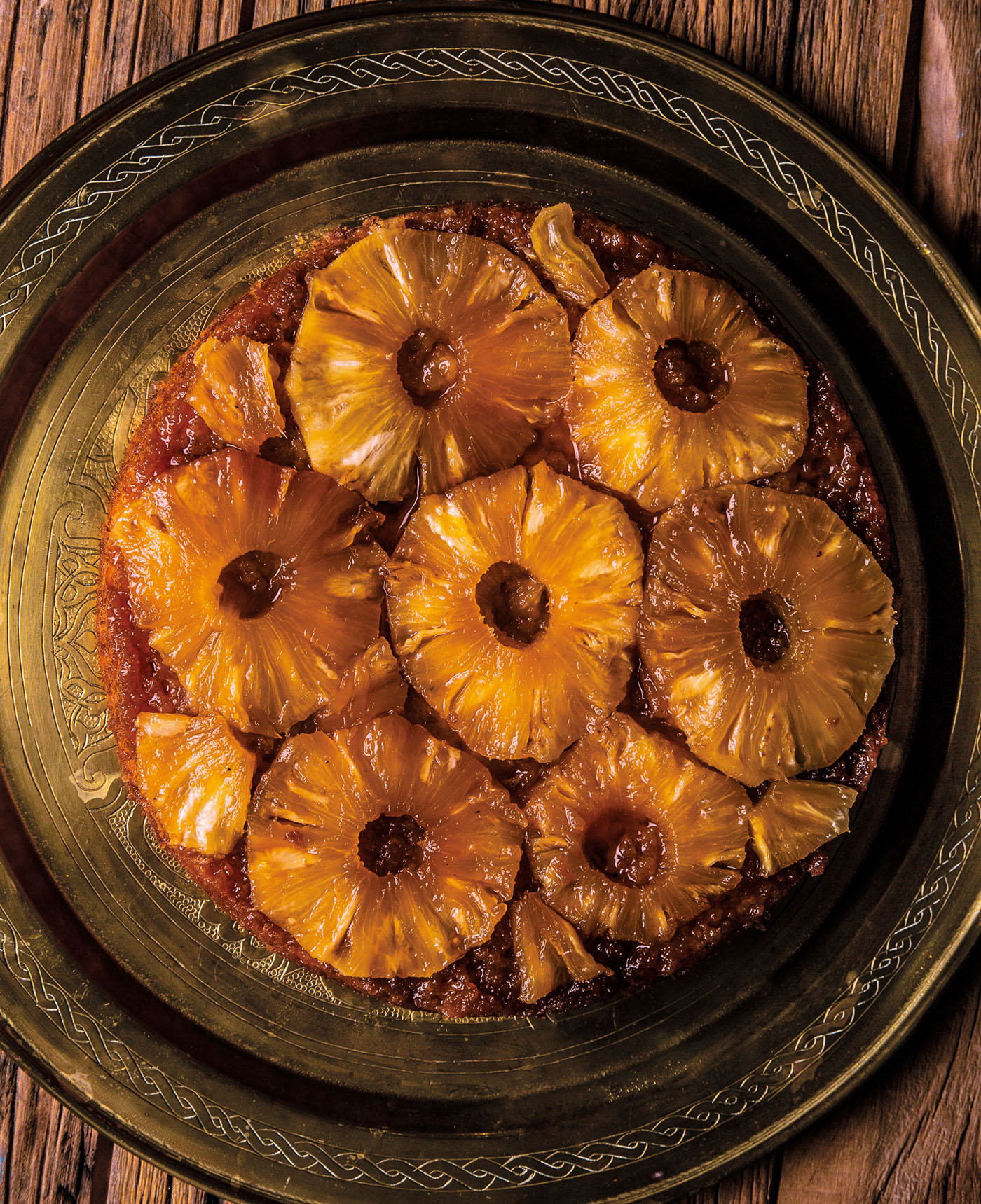
 1 round baking pan
1 round baking pan
 50 minutes
50 minutes
 Medium
Medium
• 2 EGGS
• 1 TEACUP SUGAR
• ½ TEACUP MILK
• 1 TEACUP ALL-PURPOSE FLOUR
• 2 TEASPOONS BAKING POWDER
• ½ PINEAPPLE, SLICED, CORE REMOVED
• BUTTER AND SUGAR TO GREASE THE PAN
Separate the eggs and whip the yolks with the sugar until obtaining a delicate, light-coloured cream. Add the milk whip a bit longer. Whip the egg whites until firm and gently mix them in with the yolks. Sift the all-purpose flour and gently combine the baking powder. Grease the pan with butter and sugar and arrange the pineapple slices so they cover the bottom of the baking pan. Cover with the cake batter and bake in a preheated oven at 160°C for about 35 minutes, or until golden. Remove the cake from the pan so that the pineapple slices are on the top.
CASSAVA CAKE (Bolo de aipim)
 6-8 servings
6-8 servings
 1 hour
1 hour
 Easy
Easy
• 1 WHOLE COCONUT, GRATED
• 4 TEACUPS SUGAR
• 4 EGGS
• 4 TABLESPOONS BUTTER
• 1.5 LITRE MILK
• 2.5 KG GRATED CASSAVA
Beat the coconut, sugar, eggs, butter, and milk in a blender until smooth. Pour into a bowl and add the grated cassava. Combine all the ingredients thoroughly and put everything in a greased pan. Bake in a preheated oven for 40 minutes, or until golden.
ARROWROOT CAKE (Bolo de araruta)
 8 servings
8 servings
 1 hour
1 hour
 Easy
Easy
• 4 EGGS
• 2 TEACUPS SUGAR
• 250 G ARROWROOT
• 1 TEASPOON BAKING POWDER
• 3 DROPS VANILLA EXTRACT
Firstly, whip the egg whites until they are firm. Add the yolks, sugar, and arrowroot. Whip again. Add the baking powder and vanilla extract. Grease a baking pan with butter. Pour the batter into the pan and bake in a preheated oven for 45 minutes at medium temperature.
RICE CAKE (Bolo de arroz)
 12 servings
12 servings
 30 minutes
30 minutes
 Easy
Easy
• 130 G RAW RICE
• 190 ML MILK
• 1 TEACUP OIL
• 3 EGGS
• 1½ TEACUP SUGAR
• ½ TEACUP GRATED COCONUT
• ½ TEACUP GRATED PARMESAN CHEESE
• 1 TABLESPOON BAKING POWDER
Combine the rice and milk in a container and allow to soak in the fridge for 3 hours. In a blender, mix the rice and milk with the oil and eggs. Mix until you obtain a cream. Next, using the blender's "pulse" feature, mix the sugar, coconut, grated cheese and, lastly, the baking powder. Bake for 20 minutes at 180°C in a preheated oven, in a pan that has been greased with butter and sprinkled with sugar.
BANANA CAKE (Bolo de banana)

 1 round baking pan
1 round baking pan
 50 minutes
50 minutes
 Medium
Medium
• 2 EGGS
• 1 TEACUP SUGAR
• ½ TEACUP MILK
• 6 RIPE BANANAS
• 1 TEACUP ALL-PURPOSE FLOUR
• 2 TEASPOONS BAKING POWDER
• CINNAMON POWDER, FOR SPRINKLING
FOR GREASING
• ½ TEACUP SUGAR
Separate the eggs and whip the yolks with the sugar until obtaining a delicate, light-coloured cream. Add the milk whip a bit longer. Whip the egg whites until firm and gently mix them in with the yolks. Using your hands, thoroughly mash two bananas and combine them with the whipped eggs. Slice the other bananas horizontally and set aside. Sift the all-purpose flour and add the baking powder, mixing it gently into the batter. Make a syrup with the sugar and ½ teacup of water and grease the bottom of the pan, arranging the bananas in such a way they line the whole bottom. Cover with the cake batter and bake in a preheated oven at 160°C for about 35 minutes, or until golden. Remove the cake from the pan so that the banana slices are on the top. Sprinkle with cinnamon and serve.
CARROT CAKE WITH CHOCOLATE FROSTING (Bolo de cenoura com cobertura de chocolate)

 1 rectangular baking pan
1 rectangular baking pan
 50 minutes
50 minutes
 Medium
Medium
• 3 CARROTS, PEELED
• 3 EGGS
• 1 TEACUP CORN OIL
• 3 TEACUPS ALL-PURPOSE FLOUR
• 2 TEACUPS SUGAR
• 1 TABLESPOON BAKING POWDER
ICING
• 1 TABLESPOON UNSALTED BUTTER
• 4 TABLESPOONS CHOCOLATE POWDER
• 4 TABLESPOONS SUGAR
Mix the carrots, eggs, and oil in a blender. When the mixture is smooth, slowly add the flour and, then, the sugar. Continue to mix. Finally, stop mixing and add the baking powder, mixing it in with a spoon. Grease a baking pan with butter and all-purpose flour, and bake in a preheated oven at 170°C for about 30 minutes. When the cake is almost done, combine all the icing's ingredients with ½ teacup of water and cook until thread stage. Pour the frosting over the cake and allow it to cool before serving.
CHOCOLATE CAKE WITH BRITTLE ICING (Bolo de chocolate com cobertura “que quebra”)
 6-8 servings
6-8 servings
 1 hour
1 hour
 Easy
Easy
CAKE
• 1 TEACUP LUKEWARM MILK
• 3 EGGS
• 4 TABLESPOONS MELTED BUTTER
• 2 TEACUPS SUGAR
• 1 TEACUP CHOCOLATE POWDER
• 2 TEACUPS ALL-PURPOSE FLOUR
• 1 TABLESPOON BAKING POWDER
ICING
• 8 TABLESPOONS CHOCOLATE POWDER
• 8 TABLESPOONS SUGAR
• 2 TABLESPOONS BUTTER
• 4 TABLESPOONS MILK
Mix all the batter ingredients in a blender. Pour it into a round baking pan greased with butter and sprinkled with all-purpose flour. Bake for about 40 minutes at medium temperature (180°C) in a preheated oven. For the icing, combine all the ingredients and cook over heat. Keep it over heat until it boils and begins to let go of the bottom of the pan – stir continuously. Once it boils, leave it on for another 30 seconds, then turn off the heat.
POTATO STARCH CAKE (Bolo de fécula de batata)
 8 servings
8 servings
 50 minutes
50 minutes
 Easy
Easy
• 6 EGGS, SEPARATED
• 8 TABLESPOONS SUGAR
• 1 TABLESPOON VANILLA EXTRACT
• 4 TABLESPOONS POTATO STARCH
• 1 TABLESPOON BAKING POWDER
Mix the yolks, sugar, vanilla extract, and potato starch. Next, add the whipped egg whites. Lastly, gently mix in the baking powder. Bake in a preheated oven in a previously greased pan.
CORNMEAL CAKE (Bolo de fubá)

 1 round mould with a hole in the middle
1 round mould with a hole in the middle
 40 minutes
40 minutes
 Easy
Easy
• 9 TABLESPOONS ALL-PURPOSE FLOUR
• 1⅓ TEACUPS YELLOW CORNMEAL
• 1½ TEACUP SUGAR
• 6 EGGS
• ½ TEACUP WHOLE MILK
• ⅕ TEACUP CORN OIL
• 2 TABLESPOONS BAKING POWDER
Combine all the dry ingredients, except for the baking powder. Add the yolks, milk, corn oil, mixing them with a spatula. Put in the egg whites, previously whipped until firm and, lastly, the baking powder. Mix thoroughly and pour into a greased mould. Bake at 150°C for 30 minutes, or until is baked through.
TARO CAKE (Bolo de inhame)
 6-8 servings
6-8 servings
 1h
1h
 Easy
Easy
• 1 EGG
• ½ TEACUP SUGAR
• 1 TEACUP FINELY GRATED RAW TARO
• 2 TEACUPS CORNMEAL
• 2 TEASPOONS BAKING POWDER
• 1 TEASPOON FENNEL
• 1 TEACUP MILK
Whip the egg with the sugar until it foams. Add the remaining ingredients and mix thoroughly. Pour the batter into a mould with a hole in the middle, previously greased and sprinkled with cornmeal. Bake at medium temperature for about 30 minutes, or until golden. Take it out of the mould when it's lukewarm.
ORANGE CAKE (Bolo de laranja)

 1 round mould with a hole in the middle
1 round mould with a hole in the middle
 40 minutes
40 minutes
 Easy
Easy
• ½ TEACUP BUTTER
• ½ TEACUP SUGAR
• 4 EGGS
• ORANGE ZEST, TO TASTE
• ½ TEACUP ORANGE JUICE
• 2 TEACUPS ALL-PURPOSE FLOUR
• 1 TEASPOON BAKING POWDER
Beat the butter and sugar until you obtain a pale cream. Add the yolks, orange zest and juice. Slow down the beater and add the flour little by little. At last, add the baking powder. Whip the egg whites until firm and gently mix them in with the other ingredients. Put the batter in a greased mould and bake at 170°C for 30 minutes, or until golden.
BRIDAL CAKE (Bolo de noiva)
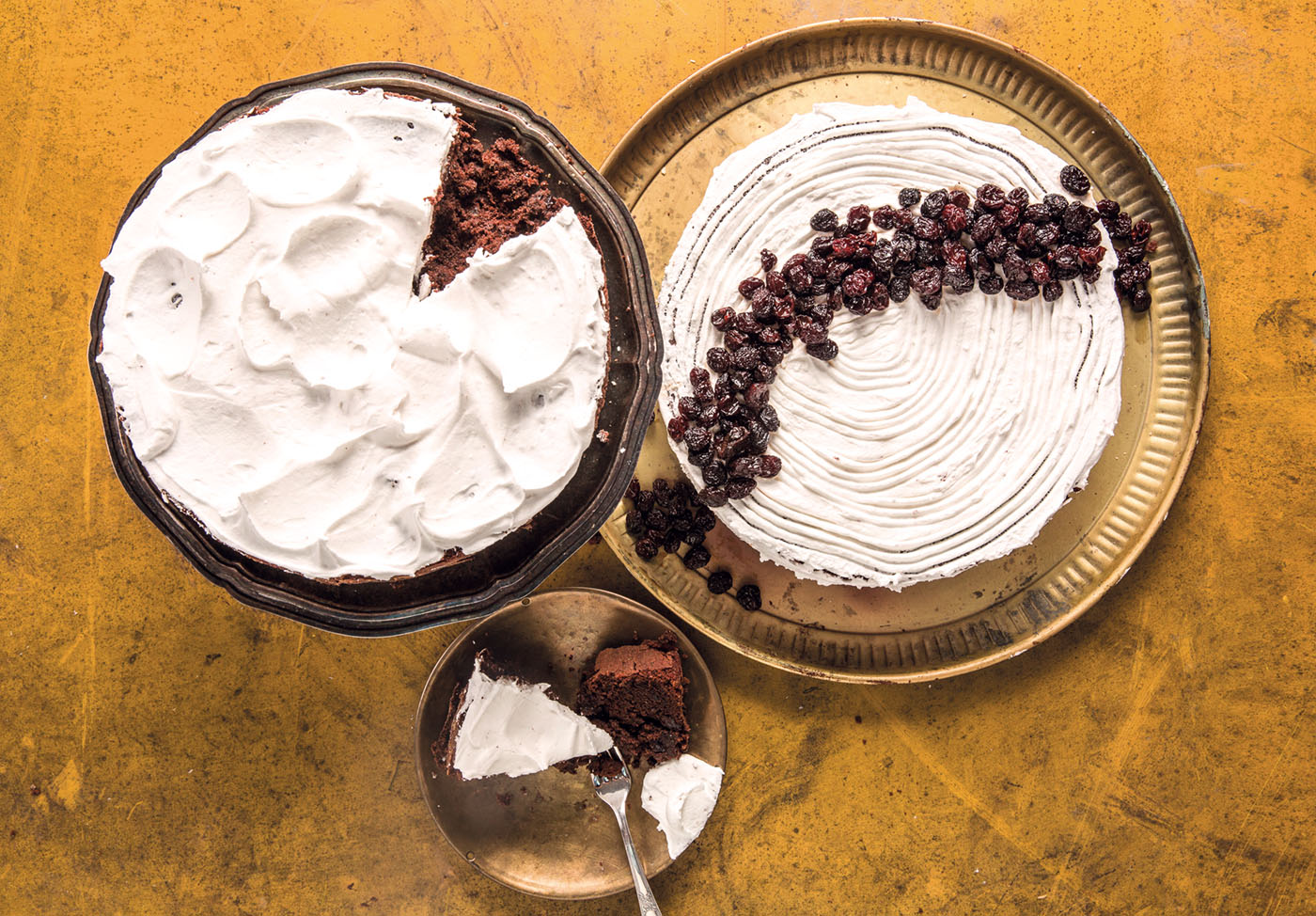
 1 large, round baking pan
1 large, round baking pan
 1 hour and a half, plus time for soaking
1 hour and a half, plus time for soaking
 Medium/Difficult
Medium/Difficult
CAKE
• 1½ TEACUP SEEDLESS RAISINS
• 1 TEACUP PORT WINE OR MUSCATEL
• 2 TEACUPS PITTED PRUNES
• 1¾ TEACUP SUGAR
• 1¼ STICK BUTTER
• 5 EGGS
• 2 TEACUPS ALL-PURPOSE FLOUR
• 1 TEACUP MILK
• ½ TEACUP COCOA POWDER
• 1 TABLESPOON BAKING SODA
• 1 TEACUP CANDIED FRUITS
• 1½ TABLESPOON BAKING POWDER
ICING
• 2 EGG WHITES
• 3 TEACUPS POWDERED SUGAR
• JUICE AND ZEST OF 1 LIME
Put the raisins in the Port wine and allow to soak for at least 24 hours. Cook the prunes with ½ teacup of sugar and ½ teacup of water over low heat until you obtain a thick syrup, stirring occasionally. Mix in a blender and set aside. Mix the butter with the remaining sugar until obtaining a pale cream. Add the yolks, one by one, saving the egg whites - you will whip them until firm later. While continuously beating, slowly add the flour and milk. Next, the cocoa powder, baking soda, candied fruits, prune syrup, and the raisins that were soaking (without the wine). Remove from the beater, beat the egg whites until firm and gently combine them with the batter. Add the baking powder and pour the batter into a pan greased with butter and all-purpose flour. Bake in a preheated oven at 170°C for about 40 minutes, or until a toothpick comes out clean after you've poked the cake with it. Remove from the oven and allow it to cool so you can apply the icing. For the icing, beat the egg whites with the powdered sugar and lime zest. Slowly add the juice until the mixture is spongy. Ice the cake and serve.
IN DETAIL
Chocolate, wine, and fruits make up the cake's moist interior, which is covered with a meringue and then decorated for weddings – hence its name. It's also present in other celebrations and many know it as "bolo pernambucano". Each family usually has its very own recipe, kept behind lock and key and handed down from one generation to the next.
CHEESE CAKE (Bolo de queijo)
 8 servings
8 servings
 1 hour
1 hour
 Easy
Easy
• 4 EGGS
• 2 TEACUPS SUGAR
• ½ TEACUP BUTTER
• 3 TEACUPS ALL-PURPOSE FLOUR
• 1 TABLESPOON BAKING POWDER
• 1½ TEACUP MILK
• 1 TEACUP GRATED PARMESAN CHEESE
• 1 PINCH SALT
Grease a mould with a whole in the middle with butter and sprinkle it with flour. Beat the egg whites until firm, add salt. Set aside In the beater's bowl, put the yolks, sugar, and butter. Beat thoroughly. Sift the all-purpose flour and the baking powder into the beater while it's running, alternating with the milk. Turn off the beater and add the grated cheese and, gently, mix in the egg whites. Put it in the mould and bake in a preheated oven at 180°C for 50 minutes.
THREE WISE MEN CAKE (Bolo de reis)
 8 servings
8 servings
 1 hour
1 hour
 Easy/Medium
Easy/Medium
• 1 TEACUP BLACK RAISINS
• ½ TEACUP BLACK PRUNES
• ½ TEACUP APRICOT
• ZEST OF 2 ORANGES
• 23 TABLESPOONS BRANDY
• 200 G BUTTER
• 1 TEACUP BROWN SUGAR
• 4 EGGS
• 1 TEACUP MILK
• 2 TEACUPS ALL-PURPOSE FLOUR
• 1 TABLESPOON BAKING POWDER
• ½ TABLESPOON CINNAMON POWDER
• ⅓ TEASPOON CHOPPED WALNUTS
• CANDIED FRUITS FOR GARNISHING
ICING
• 2 TEACUPS POWDERED SUGAR
• 4 TABLESPOONS ORANGE JUICE
Soak the raisins, prunes, apricot and orange zests in brandy. In a beater, whip the butter until you obtain a cream. Continue to whip while adding the brown sugar and yolks, one by one. Turn off the beater, add the milk stirring with a wire whip. Mix in the all-purpose flour, baking powder, candied fruits which were soaking in brandy, cinnamon powder, walnuts, and whipped egg whites. Pour the batter into a mould with a hole in the middle, with about 24 cm of diameter. It should be greased and sprinkled with flour. Bake in a preheated oven at 200°C for 40 minutes, or until golden. Allow it to cool and remove from the mould. For the icing, mix the sugar with the orange juice. Ice the cake and garnish it with the candied fruits.
IN DETAIL
The recipe for this cake that celebrates the Kings Day, on the 6th of January, has been prepared in Portugal since the 19th century. Since its origin, it usually brings a small surprise mixed in with the batter: a gold coin, or some metal trinket. The one who finds it has assured good luck in the year that is beginning.
ROLLED CAKE (Bolo de rolo)

 16 servings
16 servings
 30 minutes
30 minutes
 Difficult
Difficult
• 9 EGGS
• 9 TABLESPOONS SUGAR
• 8 TABLESPOONS ALL-PURPOSE FLOUR, SIFTED
• 2 TEACUPS CREAMY GOIABADA
• BUTTER, FOR GREASING
• GRANULATED SUGAR, FOR SPRINKLING
Thoroughly whisk the egg whites using the beater at maximum speed and, once they are quite firm, add the yolks. Add the sugar and turn off the beater. With the help of a spoon, add the sifted flour making an upwards motion. Divide the batter into two baking trays with 20 cm x 25 cm x 5 cm (you can find trays especially designed for “bolo de rolo”), greased and lined with an equally grease sheet of waxed paper. Bake in a preheated oven at medium temperature (170°C to 190°C) for 4 minutes. Remove from the tray and lay it on top of a moist dishcloth sprinkled with granulated sugar. Spread the goiabada thoroughly as a filling and roll the cake very tightly, aided by the dishcloth. Repeat the process with the second cake, rolling the second cake around the first one, forming a single, taller cake. Allow it to rest for 15 minutes before serving.
IN DETAIL
While bearing a great cake making tradition, Pernambuco state gifted the country with this famous log cake recipe with very thin layers of dough and goiabada filling. Something you should know: the slices should be cut as thin as the layers. Nowadays we see many versions, which are far from orthodox, with chocolate and dulce de leche fillings.
SPRINKLES CAKE (Bolo formigueiro)

 2 loaf pans
2 loaf pans
 40 minutes
40 minutes
 Easy
Easy
• 1 TEACUP UNSALTED BUTTER
• 1¼ TEACUPS SUGAR
• 5 EGGS
• ½ TEACUP COCONUT FLAKES
• 1 TEACUP WHOLE MILK
• 1¾ TEACUPS ALL-PURPOSE FLOUR
• 1¼ TEACUPS CHOCOLATE SPRINKLES
• 2 TABLESPOONS BAKING POWDER
Beat the butter and sugar in a beater until you obtain a cream. Add the yolks, setting the whites aside, and beat until the cream is pale. Add the coconut, milk, and sprinkle in the flour, gently mixing it in. Add the sprinkles and the baking powder and mix thoroughly. Add the eggs whites, previously whipped until firm, and combine until smooth. Pour into a grease pan and bake in a preheated oven at 140°C for 30 minutes, or until its baked through.
COLD COCONUT CAKE (Bolo gelado de coco)

 1 rectangular baking pan
1 rectangular baking pan
 1 hour and 30 minutes
1 hour and 30 minutes
 Easy
Easy
• 2 TEACUPS SUGAR
• 4 EGGS
• 2 TABLESPOONS UNSALTED BUTTER
• 1 TEACUP MILK
• 2 TEACUPS ALL-PURPOSE FLOUR
• 3 TABLESPOONS FINELY GRATED FRESH COCONUT
• 1 TABLESPOON BAKING POWDER
ICING
• 1 TEACUP SUGAR
• 285 ML COCONUT MILK
• 1 TEACUP FRESHLY GRATED COCONUT
In a blender, combine the sugar, eggs, butter, and milk. Add the all-purpose flour and grated coconut; mix. Mix in the baking powder and transfer the batter to a square or rectangular pan, greased and floured. Bake in a preheated oven at 160°C for about 35 minutes. Meanwhile, combine the ingredients for the icing. Remove the cake from the oven, allow it to cool and cut into squares. Dip each piece into the icing and gently squeeze them, removing the excess liquid; wrap them in aluminium foil if you wish. Put it in the fridge before serving.
IN DETAIL
Cake slices wrapped in aluminium were a staple of the 80's birthday parties for children. I can remember taking part in many birthday parties in the country side where the "cake" itself was a large Styrofoam structure, decked with party motifs. Inside the structure, the cold coconut cake slices were wrapped in aluminium foil to preserve their temperature and moistness. In the South region, it's known as "toalha felpuda".
ENGLISH CAKE (Bolo inglês)
 8 servings
8 servings
 40 minutes
40 minutes
 Easy/Medium
Easy/Medium
• 50 G SEEDLESS RAISINS
• 95 ML RUM
• 150 G CANDIED FRUITS
• 1 LIME
• 150 G BUTTER
• 1½ TEACUPS SUGAR
• 4 EGGS
• 2 TEACUPS ALL-PURPOSE FLOUR
• 1½ TABLESPOON BAKING POWDER
• 100 G TOASTED, PEELED ALMONDS
Combine the rum and raisins in a frying pan; cook over very low heat, without boiling. Tilt the pan over the flames, igniting the rum, and flambé the raisins. Run the candied fruits through boiling water and chop them into pieces. Grate the lime and add the zest to the raisins. Run boiling water through a deep bowl, to warm it. Beat the butter with the sugar until obtaining a smooth cream. Add the eggs, one by one, beating thoroughly after each egg. Put in the candied fruits and the sifted flour and baking powder. Grease a loaf pan and line it with waxed paper, also previously greased. Pour in the batter until reaching about ¾ of the pan's height. Arrange the almonds on top and bake in a hot oven (200°C) for 20 minutes. Turn the heat down and allow it to bake for about 30 minutes, or until being able to pull out a clean toothpick after sticking it into the cake. Remove the paper when the cake has cooled.
IN DETAIL
Besides its compact build, filled with candied and dried fruits, the “bolo inglês” is characterized by its rectangular shape and buttery texture. It's a tea-time classic, both in Europe and Brazil.
PUBA CAKE (Bolo puba)

 1 round mould with a hole in the middle
1 round mould with a hole in the middle
 50 minutes
50 minutes
 Easy
Easy
• 2 TABLESPOONS UNSALTED BUTTER
• 3 TEACUPS SUGAR
• 4 EGGS
• 500 G PUBA FLOUR
• 190 ML COCONUT MILT
• 1 TABLESPOON BAKING POWDER
• 1 PINCH SALT
Beat the butter and sugar until you obtain a pale cream. Add the yolks and beat them for bit longer. Then add the puba flour and the coconut milk while continuously beating. Whip the egg whites until firm and gently mix them in. Gently add the baking powder and salt to the batter. Bake in a greased mould in a preheated oven at 180°C for about 35 minutes, or until golden.
SOUZA LEÃO CAKE (Bolo Souza Leão)

 1 large, round cake
1 large, round cake
 1 hour and 30 minutes
1 hour and 30 minutes
 Difficult
Difficult
• 1 TEACUP SUGAR
• 2 TEACUPS UNSALTED BUTTER
• 1 TEASPOON SALT
• 1 KG PUBA MASS
• 16 YOLKS
• 3 TEACUPS COCONUT MILK
Make a syrup with the sugar and 2 teacups of water - cook it until thread stage. Remove from the heat, add the butter and salt and allow it to cool. Set aside Combine the puba mass with the sifted yolks and the coconut milk. Add the syrup to this mixture and stir until smooth. Pass the batter through a fine sieve three time. Put the batter in a greased pan and bake in a water bath for 40 minutes, or until lightly golden.
IN DETAIL
In his book "Açúcar", sociologist Gilberto Freyre tells a curious story about one of the country's most famous cakes. "I've collected several recipes for this delicacy, but they all contradict themselves, so much so I began to doubt the existence of a canonical Souza Leão cake. I've collected them like one who violates masonic secrets". In fact, the recipe for the cake, which first emerged among the Souza Leão family of Pernambuco during the sugar cane heydays, had varying details depending on the sugar mill where it came from.
BOMBOCADO
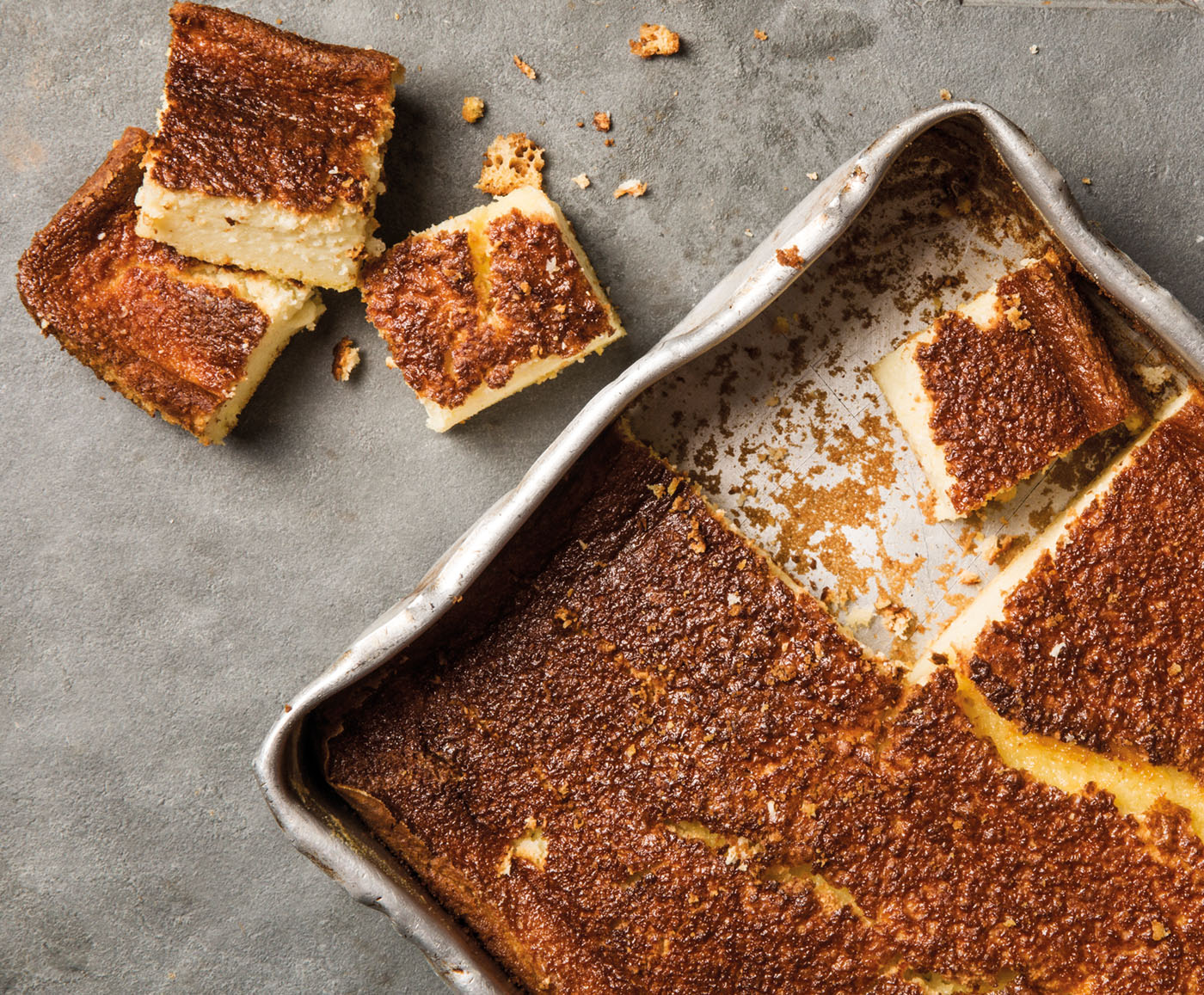
 12 servings
12 servings
 40 minutes
40 minutes
 Easy
Easy
• 2 TEACUPS SUGAR
• 2 TEACUPS WHOLE MILK
• 200 ML COCONUT MILK
• 1 DESSERT SPOON UNSALTED BUTTER
• 3 TABLESPOONS CORNMEAL
• 3 TABLESPOONS ALL-PURPOSE FLOUR
• 4 EGGS
• 1⅓ TEACUPS GRATED COCONUT
• 1 TABLESPOON BAKING POWDER
Combine all the ingredients in a blender, except for the baking powder. When the mixture is smooth, add the baking powder and mix it in with a spatula. Grease a baking pan with butter and flour and bake in a preheated oven at 170°C for 25 minutes, or until golden. Allow it to cool and serve.
IN DETAIL
The "bombocado" was commonly sold in large straw baskets carried by street vendors of seaside touristic towns. Nowadays it can be found in bakeries throughout Brazil. It's similar to the queijadinha and the grated coconut is optional.
BREVIDADE

 12 units
12 units
 40 minutes
40 minutes
 Easy
Easy
• 2 TEACUPS SUGAR
• 5 YOLKS
• 2 EGG WHITES
• 2 TEACUPS MANIOC STARCH
• 1 DASH CINNAMON POWDER
Combine all the ingredients and beat thoroughly until bubbles begin to form. Pour it into cupcake pans greased with butter and a bit of manioc starch. Bake in a preheated oven at 170°C until firm and lightly golden.
“TURNED BRIEFS” (Cueca virada)

 20 units
20 units
 1 hour
1 hour
 Medium
Medium
• 3⅓ TEACUPS ALL-PURPOSE FLOUR
• ½ TEACUP SUGAR
• 2 TABLESPOONS UNSALTED BUTTER AT ROOM TEMPERATURE
• 190 ML WARM MILK
• 2 EGGS
• 1 TABLESPOON BAKING POWDER
• CORN OIL, FOR FRYING
• SUGAR AND CINNAMON, FOR SPRINKLING
Put the flour into a bowl and open a hole in the middle. Pour in the sugar, butter, and milk and stir so it will cool down a bit. Put the eggs and baking powder in, mixing until the dough no longer sticks to your fingers. Roll out the dough and cut it into wide strips. Make a cut in the middle, in a longitudinal direction, and move the tip of the dough to the other side, forming the "briefs". Fry in preheated oil until golden and coat with a mixture of sugar and cinnamon.
IN DETAIL
This type of filhó is linked to European Christmas and New Year celebration. Probably it came to us through Italians, who make them for the Christmas festivities. Here, it received the tongue-in-cheek name due to the pastry's similarity with the piece of clothing after it's undressed. In Santa Catarina, it is known as "orelha de gato". In other regions, it's also known as "cueca rasgada".
ESPERA-MARIDO

 25 units
25 units
 2 hours
2 hours
 Medium
Medium
• 95 ML WARM MILK
• 2 EGGS
• 48 ML CORN OIL
• 2½ TABLESPOONS SUGAR
• 1 TABLESPOON BAKING POWDER
• 4 TEACUPS ALL-PURPOSE FLOUR
• CORN OIL, FOR FRYING
GLAZE
• 3 TEACUPS SUGAR
• 2 TABLESPOONS VANILLA EXTRACT
• 70 G GRATED COCONUT
In a blender, mix the milk, eggs, oil, and sugar until smooth. Pour the mixture into a bowl, add the baking powder and slowly mix in the flour, until the dough is flexible and smooth. Allow the dough to rest for 20 minutes. Separate it into equally sized balls. Then, open the dough forming a tube and tie it into a knot. Rest them for 30 minutes. Fry the little knots in very hot oil until they are golden.
For the glaze, cook the sugar along with 1 teacup of water and the vanilla extract. When it reaches thread stage, turn off the heat and throw the fried dough in, then sprinkle with coconut. Allow it to cool for a bit, then serve.
IN DETAIL
These fried rolls are a classic that can be made different ways and whose name – which translates into something like "Husband-Waiting" – is met with curiosity. In Portugal, there was already a cream, made with eggs, sugar and cinnamon, with this same name. "Sonho de pobre" is another Brazilian name for it.
FILHÓS
 30 servings
30 servings
 30 minutes
30 minutes
 Easy
Easy
• 1½ TEACUP MILK
• ¼ TEACUP CLARIFIED BUTTER
• 3 EGGS
• 3 TEACUPS SIFTED ALL-PURPOSE FLOUR
• 1½ TEASPOONS OF BAKING POWDER
• 2 LITERS OIL, FOR FRYING
• 2 TEACUPS HONEY
• 1 TEASPOON SALT
Cook the milk, butter, and 1½ teacups of water until boiling. While waiting for it to boil, whip the egg whites until firm then add the (sifted) yolks and continue to whip. Set aside In a bowl, combine the sifted flour, baking powder, and salt. Add the boiled liquid to the flour mixture and slowly stir with a spoon until lukewarm. Afterwards, knead with your hands. Add the whipped eggs and mix them thoroughly into the dough, which should be moist and smooth. Heat the oil and, with two small spoons, make balls and drop them into the oil. Stir so they will fry evenly. Ideally, all the surface should be immersed. Place the balls on a paper towel to drain out the frying oil. In another pot, heat up the honey with ½ teacup of water. Boil until it's the syrup is thick. Bath the rolls in the honey glaze. Serve them hot or cold.
IN DETAIL
In some cities in Portugal, batches of filhós are usually cooked on Christmas Eve. Here, they've also became popular in other shapes besides discs – such as hearts and flowers.
MÃE BENTA
 8 servings
8 servings
 1 hour
1 hour
 Easy
Easy
• 1 TEACUP SUGAR
• 3 TABLESPOONS BUTTER
• 2 YOLKS
• 3 TABLESPOONS GRATED COCONUT
• 1 TEASPOON RICE CREAM
• 2 TEASPOONS BAKING POWDER
• 1 TEASPOON VANILLA EXTRACT
• ½ TEACUP COCONUT MILK
• 2 EGGS WHITES, WHIPPED UNTIL FIRM
• 1 PINCH SALT
Grease and sprinkle cupcake pans. Set aside Preheat the oven at 180°C. In a beater, combine the sugar and butter, beating until obtaining a light-colored cream. Add the yolks and beat for a bit longer, combining them thoroughly. Put in the grated coconut, rice cream, baking powder, vanilla, coconut milk, salt, and beat until you obtain a smooth batter. Add the egg whites to the dough, gently mixing them in with a spatula until obtaining a smooth batter. Pour it into the cupcake pans. Bake in the oven for about 20 minutes. You can tell if the cupcakes are ready by sticking a toothpick in the middle of one and, if it comes out clean, you can take them out of the oven.
IN DETAIL
According to the book "Culinária Brasileira", by Mariza Lira, Mãe (mother) Benta really existed: her name was Benta Maria da Conceição Torres, a famed confectioner who lived in Rio de Janeiro during the regency period. "She created delicious cake recipes, which were greatly appreciated by regent Feijó, who ate them with coffee each afternoon at her house – but he was not the only one", states the author.
MANÉ PELADO

 14 servings
14 servings
 40 minutes
40 minutes
 Easy
Easy
• 3 TEACUPS RAW MANIOC, GRATED
• 1 TEACUP MEIA-CURA CHEESE, GRATED
• 70 G GRATED FRESH COCONUT
• 2 TABLESPOONS BUTTER
• 2½ TEACUPS WHOLE MILK
• 2 TEACUPS SUGAR
• 6 EGGS, BEATEN
• 1 TABLESPOON BAKING POWDER
Combine all the ingredients, except the baking powder, in a large bowl and mix them until smooth. Add the baking powder and mix for a bit longer. Grease a baking pan with butter and rice flour and pour in the batter. Bake in a preheated oven at 180°C for about 30 minutes, or until the top is golden.
IN DETAIL
Also known as "manioc and cheese cake", it's very common during the June celebrations in Goiás and Minas Gerais. Its name – literally "naked Mané" – come from a tale: apparently it pays tribute to a farmer who used to harvest manioc while...naked.
CORN CAKE (Manuê)
 6 servings
6 servings
 1 hour
1 hour
 Medium
Medium
• 5 LARGE COBS FRESH CORN
• 2 TEACUPS COCONUT MILK
• 1 MEDIUM COCONUT, GRATED
• 1 TEACUP SUGAR
• 1 TABLESPOON BUTTER, FOR GREASING
• CINNAMON POWDER, TO TASTE
• 1 PINCH SALT
Grate the corn with a grater or cut out the kernels with a knife. Set aside In a blender, combine 1 teacup of coconut milk and the grated fresh coconut with the grated corn. In a pot, over medium heat, put the mixture of corn and coconut milk, then add the sugar and a pinch of salt. Stir until you obtain a thick mush. Pour it into a baking pan greased with butter. Sprinkle it with cinnamon and pour over the remaining coconut milk. In a preheated oven, bake at medium temperature for 30 to 40 minutes. It will be done when the edges are golden.
IN DETAIL
In the menus of 19th century Salvador this manioc cake could already be found. Some local twists are added in Paraíba and Pernambuco states.
GOMA CAKE (Orelhas de burro))
 5 servings
5 servings
 35 minutes
35 minutes
 Easy
Easy
• 3 EGGS
• 1 TEACUP OIL
• 3 TEACUPS MANIOC STARCH
Mix all the ingredients in a blender. Grease the baking pan and bake in a preheated oven at 180°C for 30 minutes, or until a toothpick that has been stuck into the cake comes out clean.
SPONGE CAKE (Pão de ló)
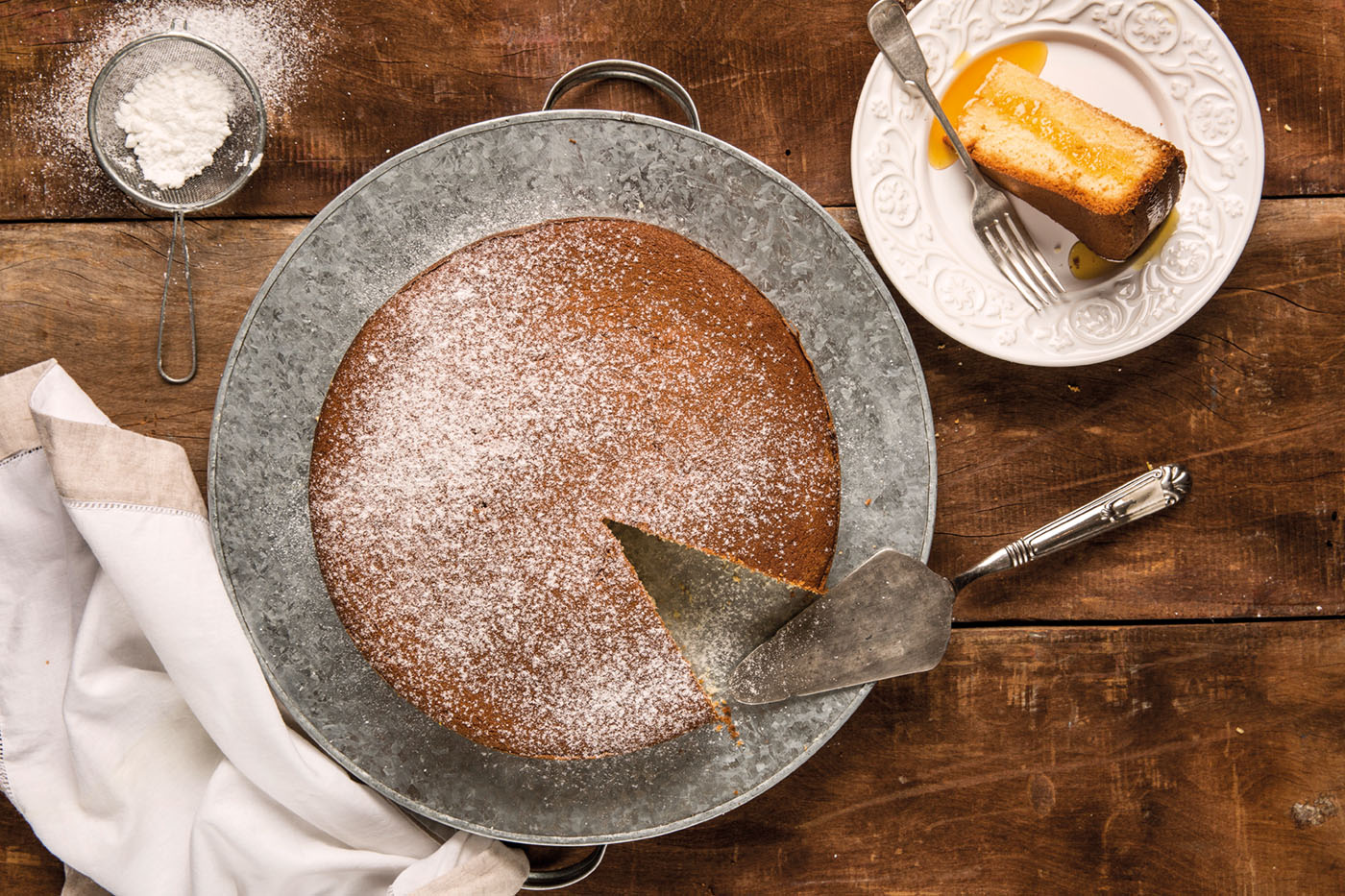
 6-8 servings
6-8 servings
 1 hour
1 hour
 Easy/Medium
Easy/Medium
• 8 EGGS
• 8 TABLESPOONS SUGAR
• 8 TABLESPOONS SIFTED ALL-PURPOSE FLOUR
• 2 TEASPOONS BAKING POWDER
• POWDERED SUGAR, FOR SPRINKLING
In a beater, beat the eggs and the sugar until they form a yellowish, light cream. Add the sifted flour and baking powder, mixing gently. Pour the batter into a springform pan. Grease only the bottom with butter and flour. Bake in a preheated oven at 160°C for about 35 minutes, or until golden. Remove from the oven and allow to cool. Sprinkle with powdered sugar and serve.
IN DETAIL
Present in our cuisine since the Portuguese colonization, it seems that “pão de ló” never goes out of style: it goes well with tea, coffee, chocolate. It's so airy that it was incorporated into a popular figure of speech: "tratado a pão de ló", "to be treated with pão de ló", meaning that a person is being very well treated. It's also part of other cake recipes as it is filled with ingredients such as dulce de leche and is garnished with sprinkled cinnamon, among other things.
HONEY BREAD (Pão de mel)
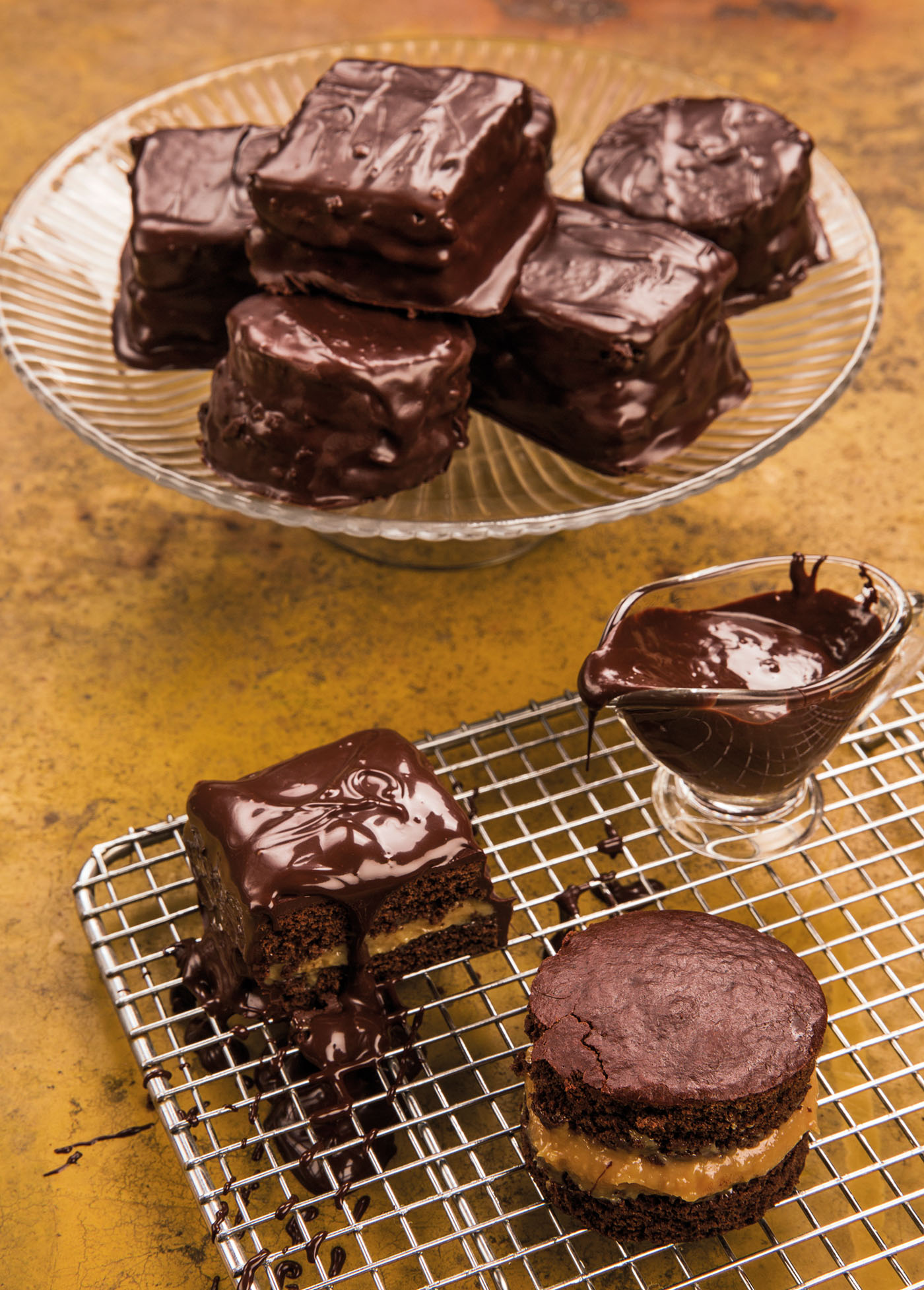
 12 units
12 units
 1 hour
1 hour
 Medium
Medium
• 2 TEACUPS ALL-PURPOSE FLOUR
• ½ TEACUP CHOCOLATE POWDER
• 2 TEASPOONS BAKING SODA
• 2 TEASPOONS CINNAMON POWDER
• 1 COFFEE SPOON GROUND CLOVE
• 1 TEACUP MILK
• ½ TEACUP HONEY
• 1 TEACUP BROWN SUGAR
• 2 TEACUPS CREAMY DULCE DE LECHE
• 3 TEACUPS CHOPPED BITTERSWEET CHOCOLATE
Combine all the dry ingredients, except for the brown sugar, and pass them through a sieve. Set aside Combine the milk, honey, and brown sugar and pour them into the dry ingredients, stirring with a wire whip or spoon. Pour the batter into small, round pans or in a greased rectangular pan. Bake in a preheated oven at 180°C for 30 minutes. Remove from the oven and allow it to cool. For the icing, melt the chocolate in a water bath and set aside. If you used a rectangular pan, take a cutter and cut the breads in a round or square shape. Then, open each one in half and fill with dulce de leche. Put them in a wire rack and pour the chocolate over them. Wait until it hardens, then serve.
QUEQUE
 10 servings
10 servings
 30 minutes
30 minutes
 Easy
Easy
• ¾ TEACUP BUTTER
• ¾ TEACUP SUGAR
• 2 EGGS
• ¾ TEACUP SIFTED ALL-PURPOSE FLOUR
• 1 TEASPOON BAKING POWDER
In a beater, beat the butter and the sugar. Add the eggs, all-purpose flour, and the baking powder. Pour into individual paper or silicon cups. Bake in a preheated oven at 180°C for about 13 minutes.
IN DETAIL
In Portugal, there are so many queques you could spend a stint over there without ever trying the same recipe twice. The name comes from the word "cake". Usually they are found in cupcake paper cups.
DULCE DE LECHE AND COCONUT LOG (Rocambole de doce de leite e coco)
 10 servings
10 servings
 30 minutes
30 minutes
 Medium
Medium
• 9 EGGS
• 9 TABLESPOONS SUGAR
• 8 TABLESPOONS ALL-PURPOSE FLOUR, SIFTED
• 1 TEACUP DULCE DE LECHE
• 1 TEACUP FRESH COCONUT
• GRANULATED SUGAR, FOR SPRINKLING
Beat the egg whites thoroughly using the beater's maximum speed. When they are quite firm, add the yolks. Put in the sugar and turn off the beater. With the help of a spoon, add the sifted flour making an upwards motion. Transfer to a 20 x 25 cm baking tray lined with an equally greased waxed-paper. Bake in a preheated oven at medium temperature (170°C to 190°C) for 10 minutes. Remove from the tray and lay it on top of a moist dishcloth sprinkled with granulated sugar. For the filling, mix the fresh coconut with the dulce de leche. Spread the filling thoroughly and roll the cake aided by the dishcloth. Allow it to rest for 15 minutes before serving.
DOUGHNUT (Sonho)

 10 units
10 units
 1 hour and 30 minutes
1 hour and 30 minutes
 Medium
Medium
• 190 ML LUKEWARM MILK
• 2 EGGS
• 48 ML CORN OIL
• 2½ TABLESPOONS SUGAR
• 1 TABLESPOON BAKING POWDER
• 4 TEACUPS ALL-PURPOSE FLOUR
• 1 LITRE CORN OIL, FOR FRYING
FILLING
• 5 TEACUPS MILK
• 1 TEACUP SUGAR
• 2 EGGS
• ½ TEACUP CORNSTARCH
• 1 TABLESPOON BUTTER
• 1 VANILLA POD, OR 5 DROPS OF VANILLA EXTRACT
In a blender, mix the milk, eggs, oil, and sugar until smooth. Pour the mixture into a bowl, add the baking powder and slowly mix in the flour, until the dough is flexible and smooth. Allow the dough to rest for 20 minutes. Divide it into 10 equally sized balls, round them so the dough is totally smooth, and allow them to rest for another 30 minutes, or until they have doubled in size. Fry in very hot oil until the dough-nuts are golden. For the cream, cook the milk and sugar over heat. Beat the eggs in a beater until they have doubled in size. Dissolve the cornstarch in warm milk and add it to the eggs, bit by bit, so it won't clog, and go back to cooking them over low heat until thick. Remove from the heat, add the butter and vanilla. Cut the doughnuts open and fill them with the cream.
IN DETAIL
An adaptation of a Portuguese sweet called "Bola de Berlim", sold in beaches, just as it is sold today in Pernambuco.
PARAGUAYAN SAVOURY CAKE (Sopa paraguaia)
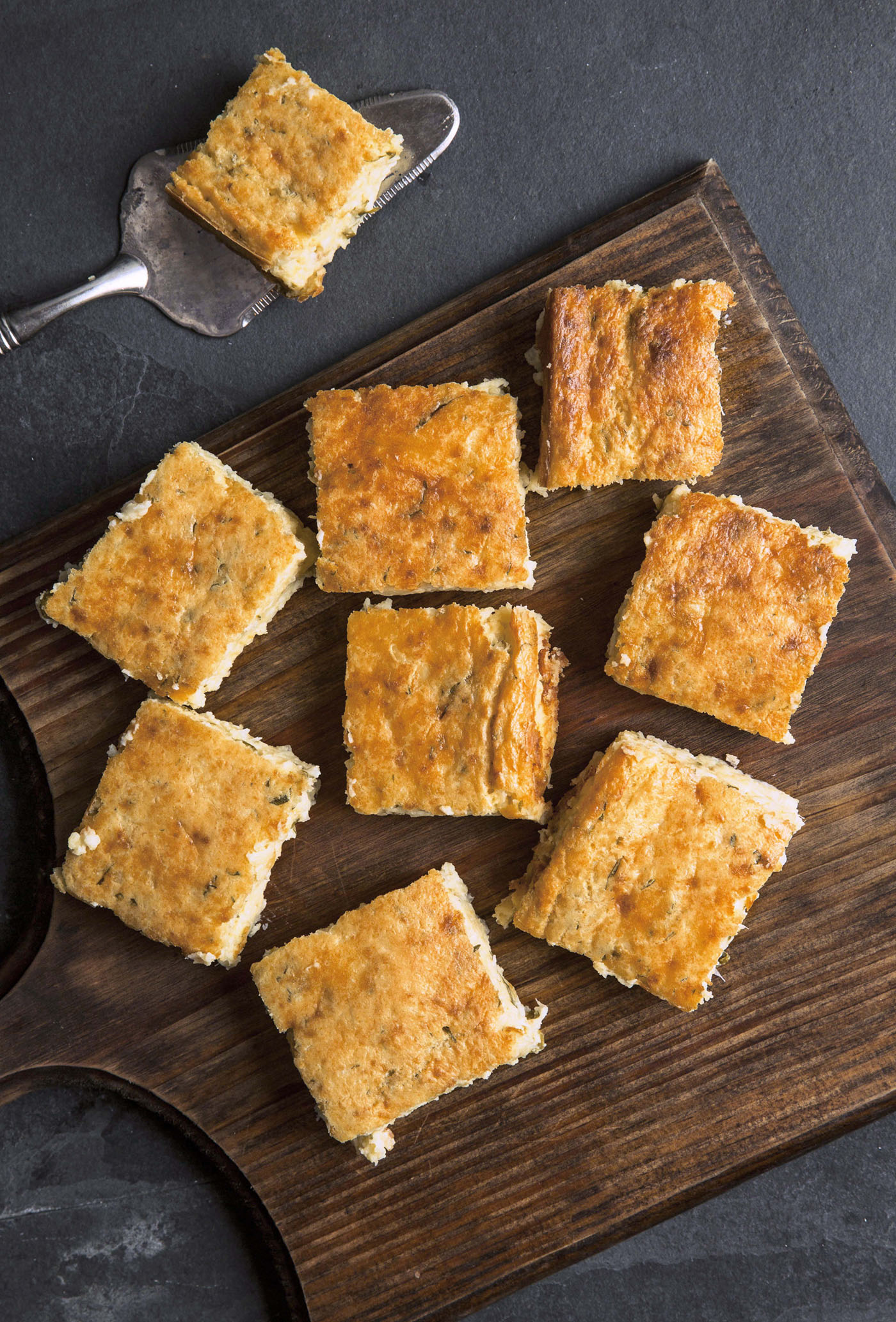
 1 large pie
1 large pie
 40 minutes
40 minutes
 Easy
Easy
• 2 MEDIUM ONIONS, GRATED
• 4 TABLESPOONS CORN OIL
• 4 TEACUPS MILK
• 2½ TEACUPS MEIA-CURA CHEESE, GRATED
• 2 TEACUPS FLAKED CORN FLOUR
• 4 EGGS
• ¼ BUNCH GREEN ONIONS, CHOPPED
• ¼ BUNCH PARSLEY, CHOPPED
• 1 TABLESPOON BAKING POWDER
• SALT TO TASTE
Braise the grated onion in corn oil, until it wilts a bit. Cover with milk and cook over medium heat. Turn off when it begins to boil and set aside. Mix the meia-cura cheese, the corn flour, the beaten eggs and the previously boiled milk, stirring until you obtain a smooth dough. Season with salt and the chopped herbs and add the baking powder. Bake in a greased baking tray at 180°C for 30 minutes, or until the pie is firm and golden.
IN DETAIL
This salty cake is another example of influences from neighbouring countries. As the name itself indicates, the recipe – which is called a "sopa" (soup), but is not a sopa – is a popular breakfast in Paraguay, a habit that spread out to the frontier cities in the Mid-West.
BREADS AND DOUGHNUTS
BIJAJICA
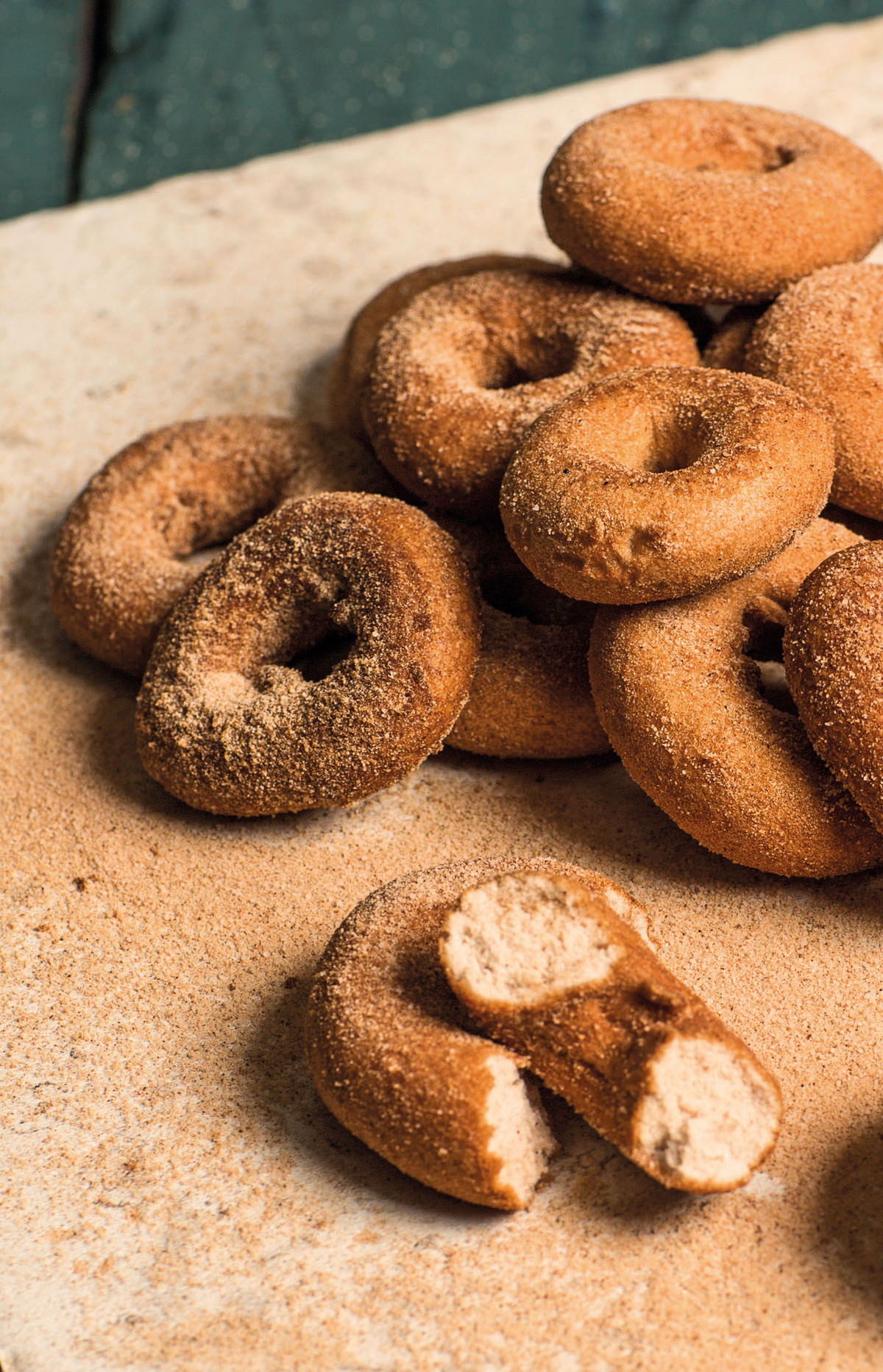
 16 units
16 units
 30 minutes
30 minutes
 Easy
Easy
• 3 LARGE EGGS
• 6 TABLESPOONS SUGAR
• 500 G MANIOC STARCH
• 1 PINCH SALT
• CORN OIL, FOR FRYING
Combine the eggs and sugar and beat thoroughly. Put in the salt and slowly add the manioc starch while mixing, until the dough no longer sticks to your hands and can be properly shaped. Make the donuts and fry them in hot oil until golden.
IN DETAIL
Typically found in the mountain ridge of Santa Catarina, these donuts originally were fried in lard. The name is shared with another recipe from the region – a baked cake that also uses manioc flour, but is garnished with brown sugar and ground peanuts.
PEANUT CORN BREAD (Broa de amendoim)
 21 units
21 units
 50 min
50 min
 Easy
Easy
• 2 TEACUPS ALL-PURPOSE FLOUR
• 2 TEACUPS CORNMEAL
• 2 TEACUPS SUGAR
• 2 TEACUPS SHELLED, TOASTED AND GROUND PEANUTS
• 2 TEACUPS MILK
• 1 TEACUP OIL
• 3 EGGS
• 1 TABLESPOON BAKING POWDER
In a blender, combine the eggs, oil, milk, and sugar. Pour the all-purpose flour, cornmeal, and ground peanuts into a container and mix thoroughly, slowly adding this mixture to the one in the blender, stirring thoroughly with a spoon (the batter should be softer than a cake batter). Finally, mix in the baking powder, grease a rectangular baking tray and bake at 170°C, in a preheated oven, for 35 minutes or until pulling out a clean toothpick. Cut into squares and serve with coffee.
CORNMEAL BREAD (Broa de fubá)

 20 units
20 units
 1 hour and 20 minutes
1 hour and 20 minutes
 Medium/Difficult
Medium/Difficult
• 2 TEACUPS CORNMEAL
• 1½ OF MANIOC STARCH
• ¾ TEACUP SUGAR
• 3½ TEACUPS MILK
• 95 ML CORN OIL
• 4 EGGS
• 1 TABLESPOON BAKING POWDER
• CORNMEAL, FOR SPRINKLING
• 1 COFFEE SPOON SALT
Combine the cornmeal, manioc starch, and sugar. Put the milk and oil in a pot and cook over heat. When it begins to boil, turn down the heat and pour it on the dry mixture. Stir continuously, until it no longer sticks to the bottom of the pot. Remove from the pot and set aside. When the dough has cooled, put in the eggs, one by one, add the baking powder and salt and knead, with your hands, until the dough is smooth. Grab a mug with a round bottom and put in some cornmeal, for sprinkling. Take a spoonful of dough and put it in the mug, rotating the mug to make the dough round. Bake in a baking tray greased with butter and cornmeal.
CUCA
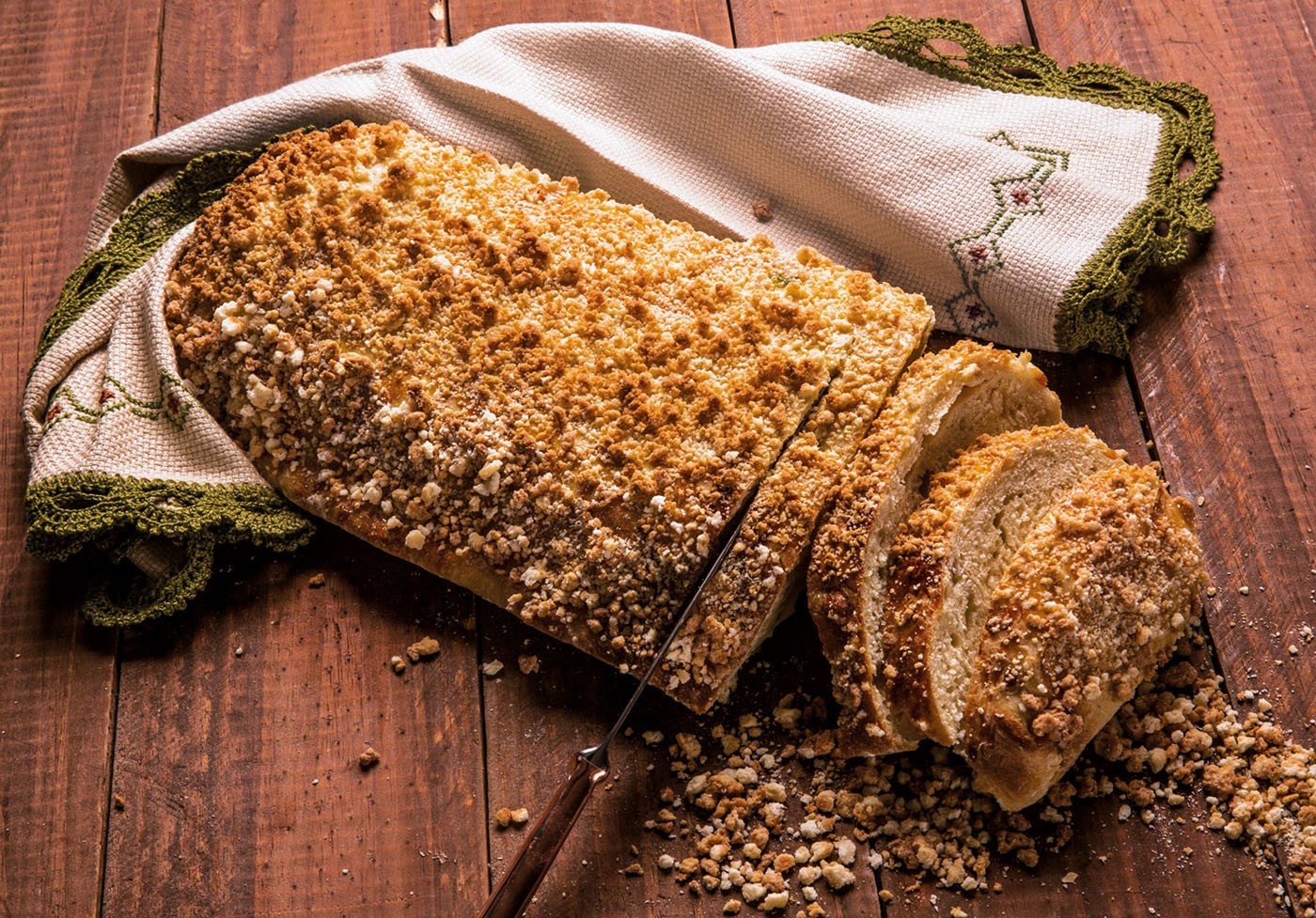
 1 large unit
1 large unit
 3 hours
3 hours
 Medium/Difficult
Medium/Difficult
• 2 EGGS
• ½ TEACUP SUGAR
• 1 TEASPOON SALT
• 3 TABLESPOONS BUTTER OR LARD
• 2 TEACUPS ALL-PURPOSE FLOUR
• 2½ TABLESPOONS BAKING POWDER
• 1½ TEACUPS WHOLE MILK
• 1 YOLK, FOR BRUSHING
FOR THE CRUMBLE
• ¼ TEACUP SUGAR
• 1¼ TEACUPS ALL-PURPOSE FLOUR
• 2 TABLESPOONS NATA (HEAVY CREAM)
• ZEST OF ½ LIME
Beat the eggs with the sugar and salt. Add the butter and slowly put in the all-purpose flour, until the dough is smooth. Add the baking powder and knead the dough until it is smooth and no longer sticks to your hands. Allow it to rest for 3 hours at room temperature. Make the crumble mixing all ingredients; set aside. Grease a baking pan with butter and flour and put in the dough. Brush it with the yolk and cover with the crumble. Bake in a preheated oven at 180°C for 20 minutes, or until it's golden and baked through.
IN DETAIL
The name is a Portuguese adaptation of the word küche – a traditional German cake which was brought by German settlers to the South of Brazil. The biggest difference between the cuca and other breads or cakes is the crunchy crumble that covers the dough.
HOMEMADE BREAD (Pão caseiro)

 1 large unit
1 large unit
 3 hours
3 hours
 Medium
Medium
• 2 EGGS
• 5 TABLESPOONS SUGAR
• 1 LEVEL TABLESPOON DRY YEAST
• ¾ TEACUP MILK
• 1½ TABLESPOONS BUTTER
• ½ TEASPOONS SALT
• 500 G ALL-PURPOSE FLOUR
Separate the egg whites from the yolks. Whip the egg whites until firm, add the yolks, one by one, and then 3 tablespoons of sugar. Set aside Heat up ¼ teacup of water for 1 minute, just so it will accelerate the yeast's reaction. Put in the yeast and the remaining sugar and allow to rest for 5 minutes. Meanwhile, also quickly heat up the milk, butter, and salt. Put the flour on the counter or in a container and open a whole in the middle. Put in the liquids, stirring while pouring them. Put the beaten eggs last of all and mix the dough until it is smooth and no longer sticks to the hands. Allow it to rest for 30 minutes on a tray greased with a bit of oil. Shape the bread and allow it to rest for another hour and a half. Bake at 180°C for 20 to 25 minutes. Wait until cool before slicing. If you wish for a crispier crust, put a tray with water on the bottom part of the oven, allow it to heat up and then put in the dough.
POTATO BREAD (Pão de batata)
 20 units
20 units
 1h30
1h30
 Medium
Medium
• 2 LARGE POTATOES, PEELED
• 500 G ALL-PURPOSE FLOUR, PLUS A BIT EXTRA FOR SPRINKLING
• 2 EGGS
• ½ DESSERT SPOON OF SALT
• 50 G FRESH ACTIVE YEAST
• 1 TABLESPOON BUTTER
• 2 TABLESPOONS SUGAR
• ½ TEACUP OIL
• 2 YOLKS, FOR BRUSHING
Cook the potatoes in water, drain and mash them in a bowl while they're still hot. In the centre, add 300 g of all-purpose flour, eggs, salt, and the yeast. In the sides, put in the butter and sugar. Be careful not to mix the sugar with the yeast at first. Put the oil in the centre and begin to stir, first combining the central ingredients. Stir thoroughly and continue to the sides, until you've mixed all the bowl's contents. Add the reaming flour and knead thoroughly, sprinkling a bit of flour so the dough won't stick. The dough should be done when it's still a bit soft, smooth, and not sticking to the hands. Allow it to rest for about 30 minutes. Divide the dough into twenty small balls, transfer them to a greased and floured tray, brush with the yolk and allow them to rise for another 30 minutes. Preheat the oven at 180°C and bake for 40 minutes, or until golden.
DELÍCIA BREAD (Pão delícia)
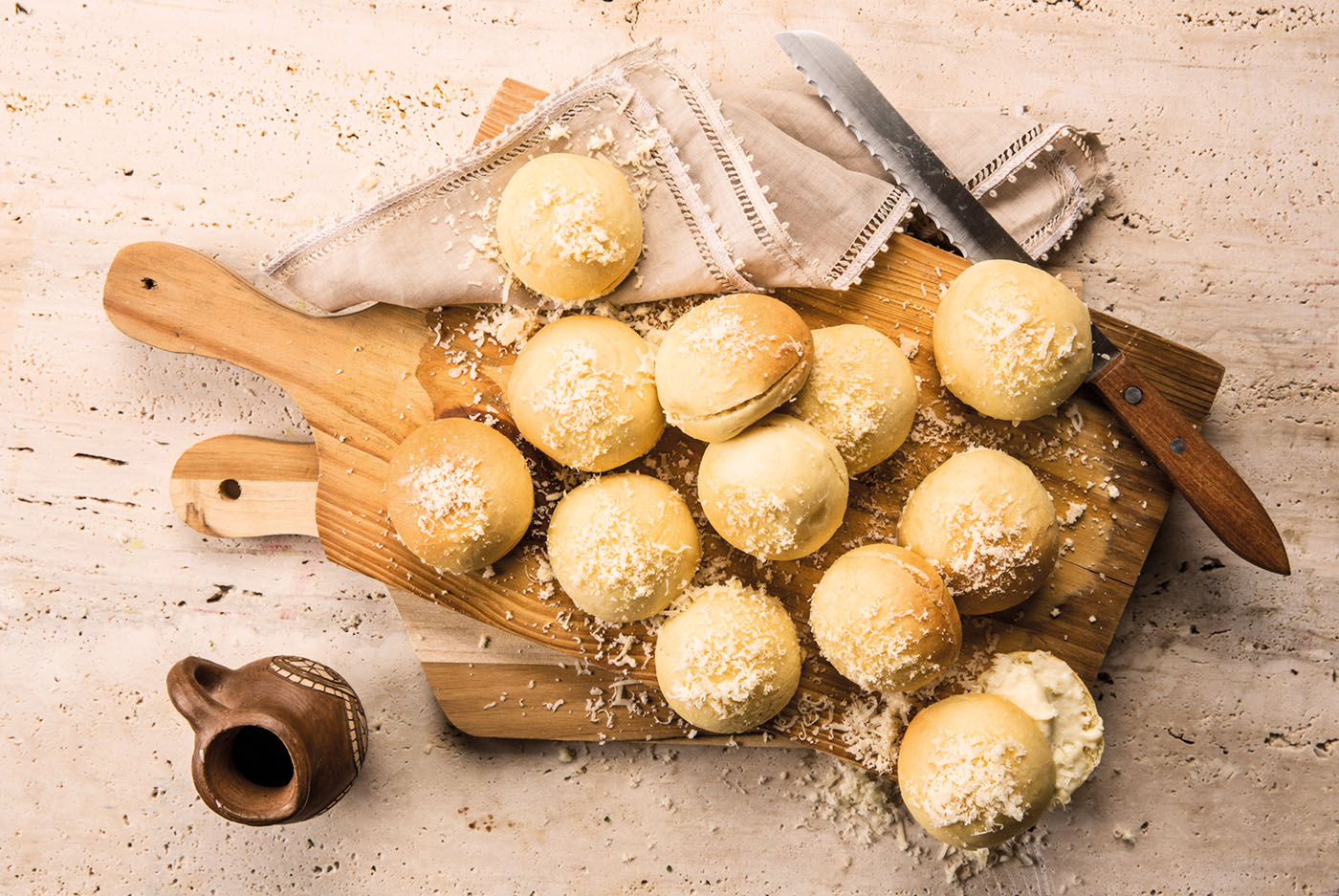
 50 units
50 units
 3 hours
3 hours
 Medium
Medium
• 3 EGGS
• 9 TABLESPOONS SUGAR
• ½ TEACUP WATER
• 1½ TABLESPOONS DRY YEAST
• 1½ TEACUP MILK
• 3 TABLESPOONS BUTTER
• 1 TEASPOON SALT
• 1 KG ALL-PURPOSE FLOUR
FILLING
• 2 TABLESPOONS UNSALTED BUTTER
• 4 TABLESPOONS ALL-PURPOSE FLOUR
• 3 TEACUPS MILK
• 3 TEACUPS FINELY GRATED PARMESAN CHEESE
Separate the egg whites from the yolks. Whip the egg whites until firm, add the yolks, one by one, and then the 6 tablespoons of sugar. Set aside Heat up ¼ teacup of water for 1 minute, just so it will accelerate the yeast's reaction. Put in the yeast and the remaining sugar and allow to rest for 5 minutes. Meanwhile, also quickly heat up the milk, butter, and salt. Put the flour on the counter or in a container and open a whole in the middle. Put in the liquids, stirring while pouring them. Put the beaten eggs last of all and mix the dough until it is smooth and no longer sticks to the hands. Roll the breads into cocktail sized balls (knowing they will double in size) and allow them to rise for about 1 hour. Meanwhile, work on the filling, melting the butter and adding flour, stirring constantly until a cookie like aroma emerges. Add the milk, still stirring, until you obtain a thick cream. Season with a pinch of salt and ½ teacup of Parmesan and set aside. Bake the breads, on a baking tray covered with aluminium foil, in a preheated oven at 170°C for about 30 minutes (they shouldn't be golden). Allow the breads to cool for a bit, covered with a dishcloth. Open without separating them, spread a spoonful of filling, and sprinkle with Parmesan.
IN DETAIL
Typical of Salvador, this small bread is present in celebrations as well as everyday life. The secret of this recipe is in knowing how to handle the dough, as the treats should be light-coloured and the filling, creamy. Bakeries and supermarkets in Southern states also have begun to sell this type of bread.
MANIOC BREAD (Pão de mandioca)
 20 units
20 units
 1h30
1h30
 Medium
Medium
• 300 G MANIOC
• 500 G ALL-PURPOSE FLOUR
• 2 WHOLE EGGS, PLUS 2 YOLKS, FOR BRUSHING
• ½ DESSERT SPOON OF SALT
• 50 G FRESH ACTIVE YEAST
• 1 TABLESPOON BUTTER
• 1 TABLESPOON SUGAR
• ½ TEACUP CORN OIL
Cook the manioc in water; drain and mash them inside a bowl, while still very hot, removing the central fibre. In the centre of the bowl, add 300 g of all-purpose flour, the eggs, salt, and yeast. In the sides, put in the butter and sugar. Be careful not to mix the sugar with the yeast at first. Put the oil in the centre and begin to stir, first combining the central ingredients. Stir thoroughly and continue to the sides, until you've mixed all the bowl's contents. Add the reaming flour and knead thoroughly, sprinkling a bit of flour so the dough won't stick. The dough should be done when it's still a bit soft, smooth, and not sticking to the hands. Allow it to rest for about 30 minutes. Divide the dough into twenty small balls, transfer them to a greased and floured tray, brush with the yolk and allow them to rise for another 30 minutes. Preheat the oven at 180°C and bake for 40 minutes, or until golden.
CORN BREAD (Pão de milho)

 1 whole loaf pan of bread
1 whole loaf pan of bread
 1 hour and 30 minutes
1 hour and 30 minutes
 Easy/Medium
Easy/Medium
• 1¼ TEACUPS ALL-PURPOSE FLOUR
• ¾ TEACUP FINE CORNMEAL
• 2 TEASPOONS BAKING POWDER
• ⅓ TEACUP SUGAR
• 1¼ TEACUPS MILK
• 4 TABLESPOONS BUTTER
• 1 EGG
• 1 PINCH SALT
Combine all the dry ingredients: flour, cornmeal, sugar, salt, and baking powder. In another container, mix the milk, melted butter, and egg. Pour the liquids over the dry ingredients and combine thoroughly. Put the dough in a greased loaf pan. Bake in a preheated oven at 190°C for 10 minutes. Lower to 160°C and bake for another 15 to 20 minutes. Wait until it cools and serve.
SAVOURY CHEESE BREAD (Pão de queijo)
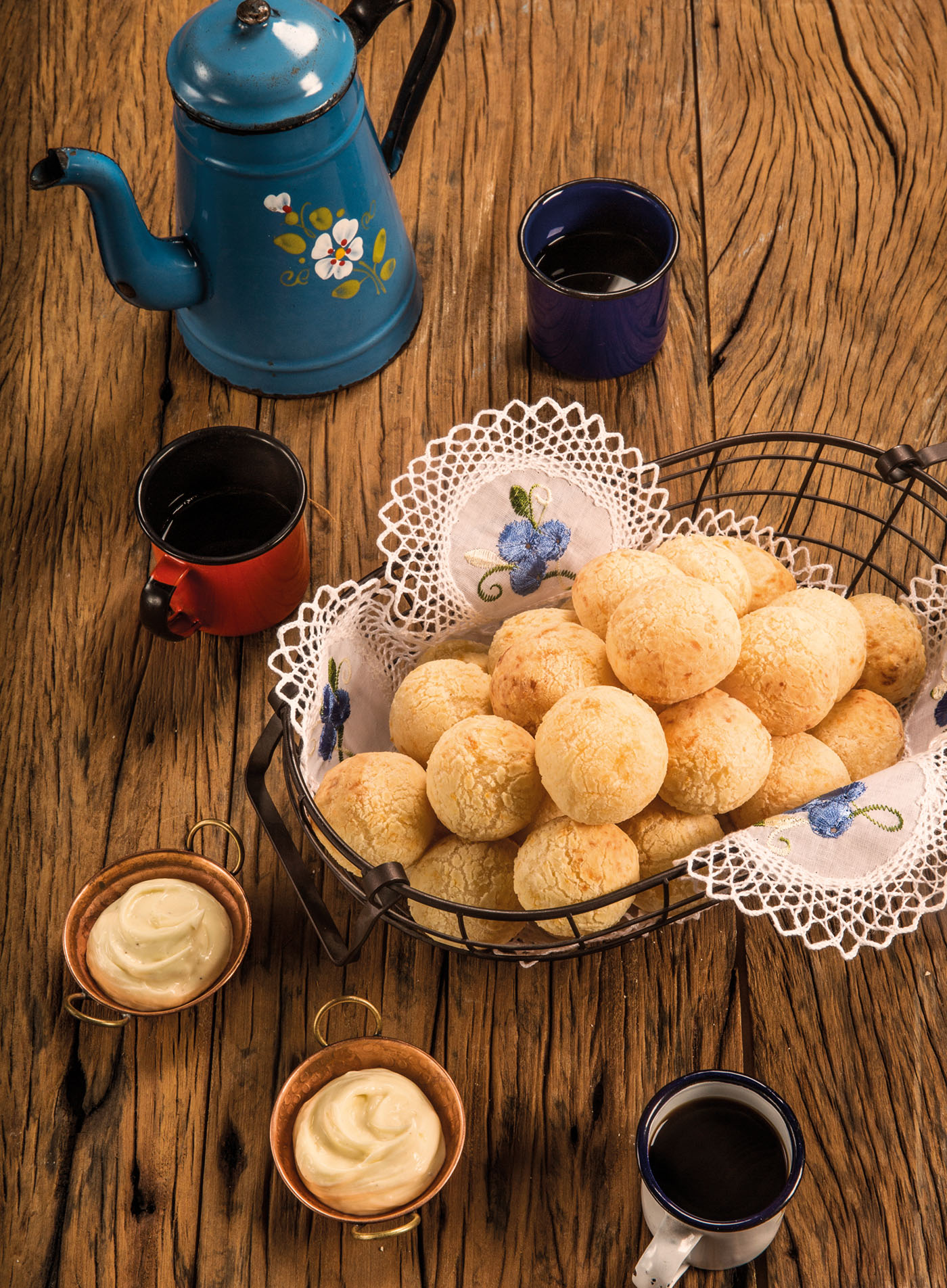
 30 units
30 units
 1 hour
1 hour
 Medium
Medium
• 1 KG MANIOC STARCH
• 1½ TEACUPS MEIA-CURA CHEESE, GRATED
• 2 TEACUPS MILK
• 1 TEACUP OIL
• 6 EGGS
• 2 TABLESPOONS SALT
Mix the manioc starch with the meia-cura cheese; set aside. Combine 2 teacups of water with the milk and oil, then cook until it begins to boil. Remove from the heat and slowly pour it over the manioc starch to heat it, stirring until you obtain a crumbly dough. When it cools, add the grated cheese and eggs, stirring again until smooth. Shape into balls and bake in a preheated oven at 180°C for about 20 minutes.
IN DETAIL
Each family from Minas has its own little secret for the pão de queijo dough. But the fact is that this classic treat conquered the whole country many decades ago. Traditionally, ripened cheese and artisanal manioc starch are part of the recipe.
CRACKLING BREAD (Pão de torresmo)
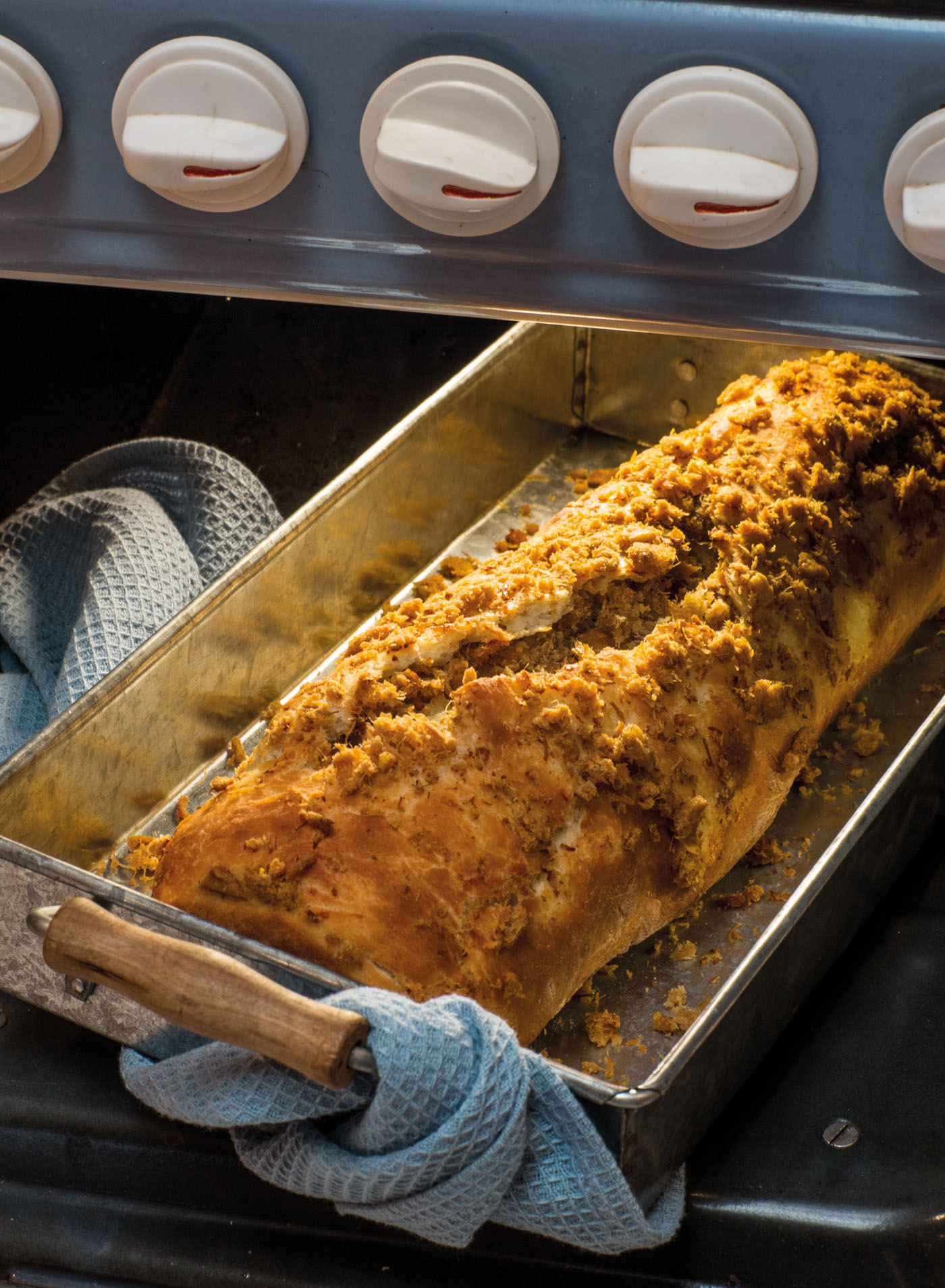
 15 units
15 units
 2 hours
2 hours
 Medium
Medium
• 1 TABLESPOON SUGAR
• 15 G FRESH ACTIVE YEAST OR 5 G OF BAKING POWDER
• 3 TABLESPOONS OLIVE OIL
• 1 TABLESPOON SALT
• 3½ TEACUPS ALL-PURPOSE FLOUR
• 4 TEACUPS FRIED AND GROUND CRACKLING
For the dough, combine the sugar, yeast, olive oil, salt, and 250 ml of water in a bowl. Add the flour and mix until you obtain a dry and smooth dough. Allow it to rise, covered with a dishcloth, for about 40 minutes. Roll out the dough, add 2 teacups of crackling bits and mix them in with your hands, until thoroughly combined. Let it rise for 40 minutes. Roll out the dough with a rolling pin, spread 1 teacup of crackling bits and shape into balls (or whichever shape you wish). Cover with 1 teacup of cracking, pressing them down so it won't come loose, and let it rise for another 40 minutes. Bake in a preheated oven at 180°C, until golden.
SWEET ROLLS (Pão doce)
 12 units
12 units
 3 hours
3 hours
 Easy/Medium
Easy/Medium
• 160 ML MILK
• 1½ TEASPOONS ACTIVE DRY YEAST
• 5 YOLKS, AT ROOM TEMPERATURE
• 3½ TEACUPS ALL-PURPOSE FLOUR
• 2 TABLESPOONS SUGAR
• 4 TABLESPOONS GRANULATED SUGAR, FOR SPRINKLING
• ¾ TEACUPS SOFTEN BUTTER, CUT INTO SMALL CUBES
• 1 EGG, FOR BRUSHING
• 1 PINCH SALT
In a bowl, combine half the milk and the dry yeast, dissolving it. Leave it somewhere warm for about 15 minutes, until bubbles begin to form. In another bowl, mix the remaining milk with the lightly beaten yolks, add the flour, sugar, and a pinch of salt and stir enough to combine everything. Open a hole in the centre and put in the yeast. Spread it out over a counter and knead the dough until it's soft. Slowly, add ⅓ of butter at a time and knead quickly until the butter has been combined into the dough. Be sure that you're working in a ventilated area, as the butter will melt with the warmth of your hands and become sticky. Transfer the dough to a bowl greased with butter, cover, and let it rise for 1 and half hours to 2 hours, until it has doubled in volume. Roll out the dough with your fist and put it over a surface sprinkled with flour, forming a roll that can be fit into a 11 x 24 cm loaf pan greased with butter. Cover with a cloth and allow it to rise for 30 more minutes. Preheat the oven at 170°C (medium) and brush the surface of the dough with the lightly beaten egg. Sieve sugar on top and bake for 30 minutes, or until it rises and is golden.
FRENCH TOAST (Rabanada)

 6 servings
6 servings
 20 minutes
20 minutes
 Easy
Easy
• 3 ROLLS
• 2 TEACUPS MILK
• 2 TEACUPS SUGAR
• 3 EGGS
• 4 TABLESPOONS BUTTER
• ½ TEACUP CINNAMON POWDER
Slice the rolls. Mix the milk, half the sugar, and the thoroughly beaten eggs. Dip both sides of the bread in milk, then fry in butter. Then coat it with sugar and cinnamon; serve.
IN DETAIL
Present in Portugal's Christmas dinners to this day, the French toast is also known as "fatia de parida" or "fatia dourada". In Bahia, it was served with coffee, just as fried bananas with cinnamon and sugar or cooked and roasted breadfruit.
BRAIDED BREAD (Rosca)
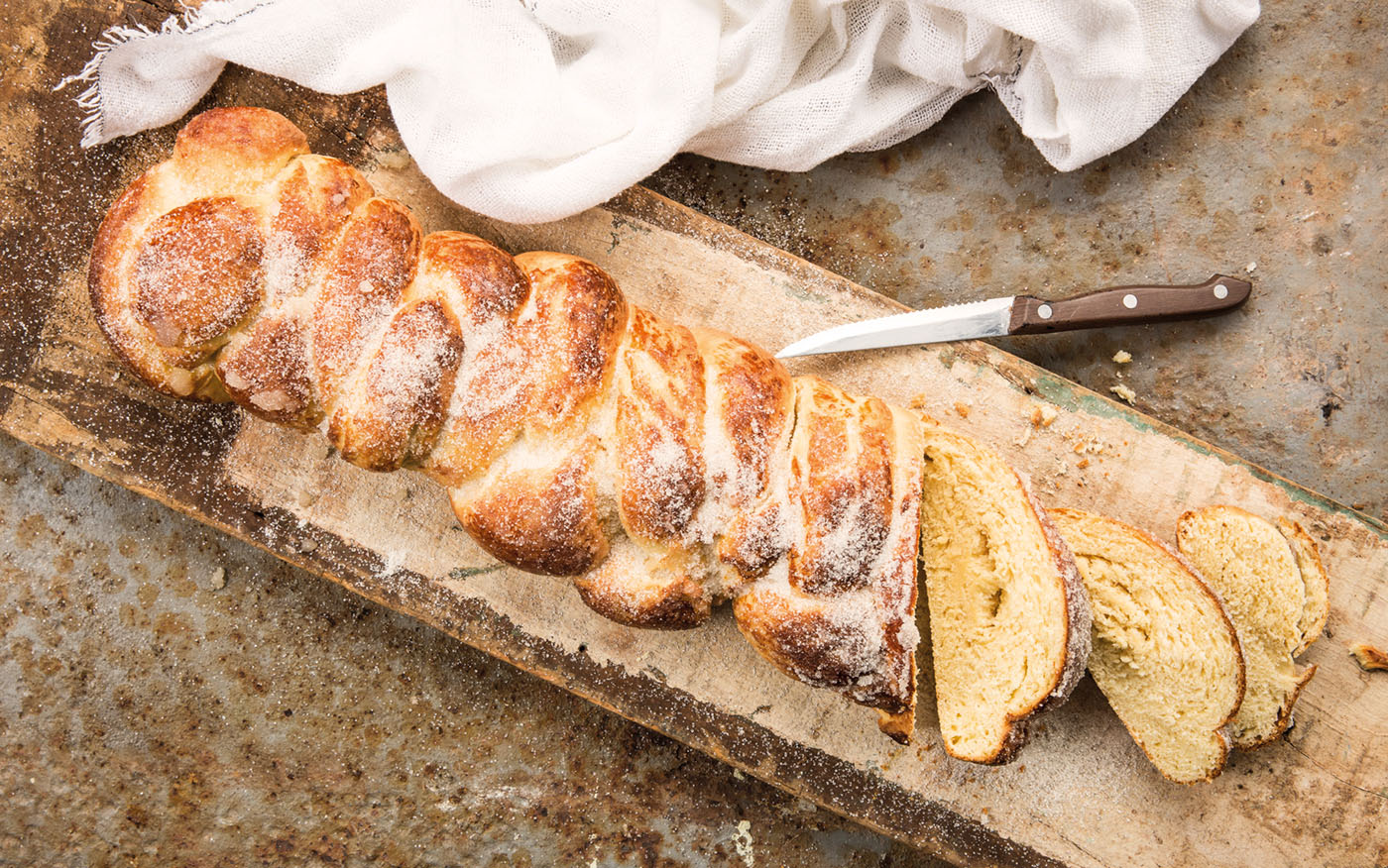
 1 large donut
1 large donut
 3 hours
3 hours
 Medium/Difficult
Medium/Difficult
• 1 TEACUP MILK
• ½ TEACUP SUGAR
• 1 HEAPING TABLESPOON DRY YEAST
• 4 TEACUPS ALL-PURPOSE FLOUR
• 3 EGGS, BEATEN
• ¾ STICK UNSALTED BUTTER
• 1 PINCH SALT
• 2 YOLKS
• GRANULATED SUGAR, FOR SPRINKLING
Mix the milk, sugar, yeast and ½ teacup of all-purpose flour and make a sponge; cover and let it rest for 45 minutes. When it has doubled in size, put the flour on the counter, open a hole in the middle and put in the eggs, butter, and salt. Mix it in with the sponge and knead the dough until smooth. Roll out the dough with a rolling pin until you obtain a rectangle. Cut it into 3 pieces and braid those three pieces; allow it to rest for 30 to 40 minutes, or until it has doubled in size. Brush it with the yolks and sprinkle a bit of granulated sugar. Bake in a preheated oven at 170°C for 30 minutes, or until golden. As soon as you remove it from the oven, sprinkle a bit more of granulated sugar. Allow it to cool and serve.
BRAZILIAN NUT DOUGHNUTS (Rosquinha de castanha-do-brasil)
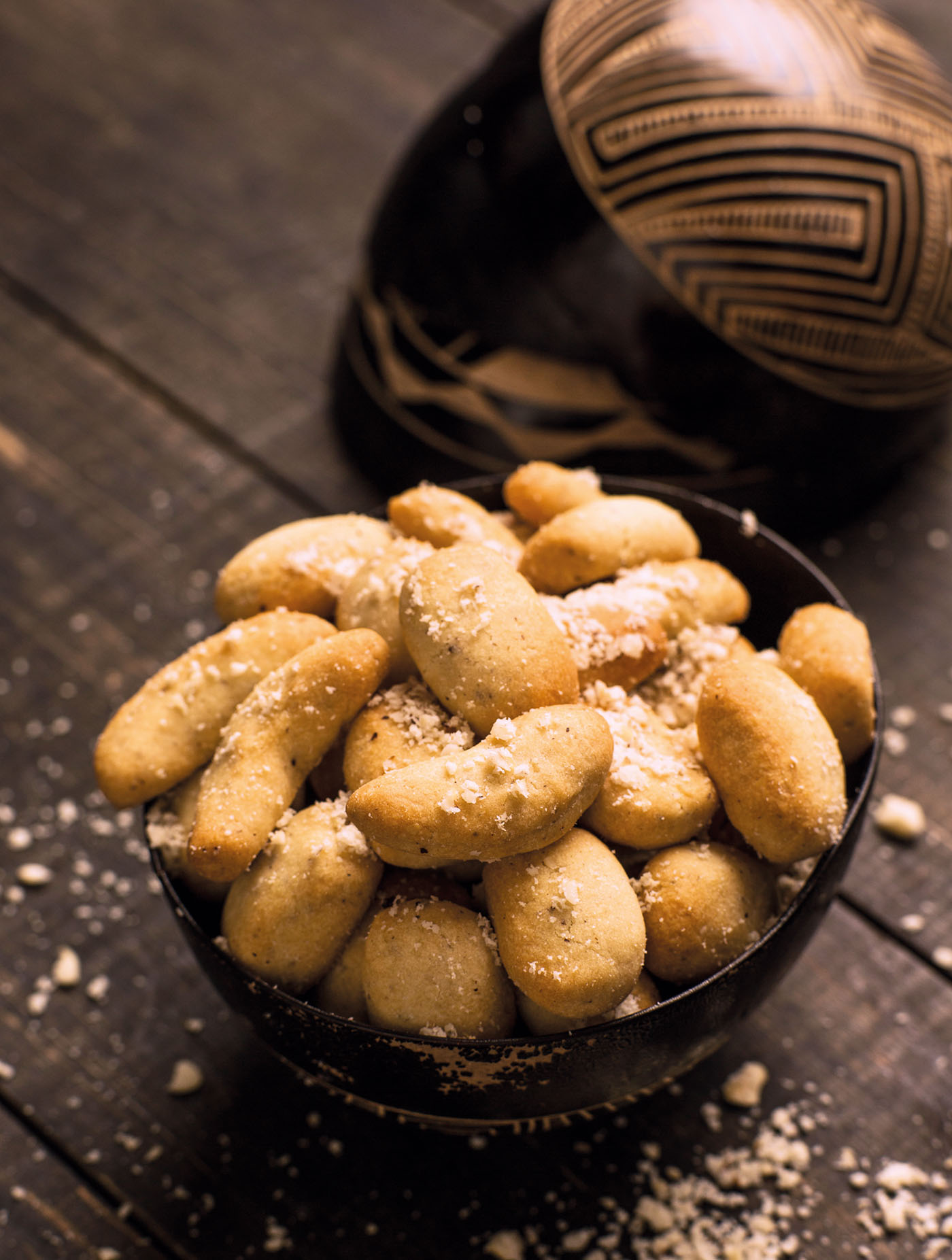
 40 servings
40 servings
 40 minutes
40 minutes
 Easy
Easy
• 1 STICK BUTTER
• 1 TEACUP SUGAR
• 2 TEACUPS GROUND BRAZILIAN NUTS
• ½ TEACUP ALL-PURPOSE FLOUR
• 1½ TEACUPS CORNSTARCH
• 1 PINCH SALT
Beat the butter and sugar until you obtain a pale cream. Add the remaining ingredients and beat thoroughly, forming a firm and smooth dough. Shape the cookies like Brazilian nuts and put them on a greased tray. Bake in a preheated oven at 160°C for 20 minutes, or until they are lightly golden and firm. Allow it to cool and serve.
CACHAÇA DOUGHNUTS (Rosquinha de pinga)
 40 servings
40 servings
 30 minutes
30 minutes
 Easy
Easy
• 1 TEACUP CACHAÇA
• ¾ TEACUP MELTED PORK LARD
• 1 TABLESPOON SUGAR
• 1 TABLESPOON FENNEL
• 3½ TEACUPS ALL-PURPOSE FLOUR
• CACHAÇA, FOR BRUSHING
• SUGAR, FOR SPRINKLING
Heat up the lard and put in the fennel, so it releases its flavour. Set aside Mix the cachaça, lard, sugar, and all-purpose flour until obtaining a smooth dough. Shape the donuts, making a strand and then joining the ends, like rings. On a greased and floured tray, bake in a preheated oven at 180°C for 20 minutes, or until lightly golden. Do not allow them to brown. While still hot, brush them with the cachaça and coat with sugar. Allow it to cool and serve with coffee.
SPREADS AND JAMS
The basic principle could not be simpler: fruits and sugar, slowly cooked, until they reach the point of a spread. Typical in the Southern region, the chimia (or schmear) – which could also be spelled as “schmier” or “chimíer”, among other variations – is thicker and pastier. When it comes to jam, its characteristic consistency requires sugar, water, some acid and pectin, a substance found in fruits that helps to thicken the mixture that's in the pot.
BLACKBERRY SPREAD (Chimia de amora)

 4-6 servings
4-6 servings
 1 hour
1 hour
 Easy
Easy
• 500 G FRESH BLACK MULBERRIES
• 2 TEACUPS SUGAR
• 2 TEACUPS WATER
Cook all ingredients over medium heat, stirring until the sugar dissolves. Lower the heat and cook until obtaining the consistency of a jam, stirring occasionally. If you want it to be more rustic, leave the mulberries whole. If you'd rather have it smoother, crush the mulberries while cooking them.
IN DETAIL
Chimias are different from jams because they have no sauce, but the pulp and, frequently, the peel of the fruit, and because usually they take longer to prepare. The term is an adaptation of the German word “schmier”, meaning "something pasty". It's typical of Rio Grande do Sul's cuisine.
BACURI JAM (Geleia de bacuri)
 12 servings
12 servings
 20 minutes
20 minutes
 Easy
Easy
• 3 TEACUPS BACURI PULP
• 3 TEACUPS SUGAR
• PEEL OF 1 LIME
Cover the bacuri with water and cook until soft. Drain and, in the same pot, cover the bacuri with sugar. Add 2 teacups of water and the lime peel. Cook until obtaining a thick syrup. Allow it to cool and put it in the fridge. Serve cold.
JABUTICABA JAM (Geleia de jabuticaba)

 1 large jar
1 large jar
 1 hour
1 hour
 Easy
Easy
• 1 KG FRESH JABUTICABA
• 500 G SUGAR
Squeeze the jabuticaba in a strainer; set the peels aside and squeeze the seeds so you can harvest all the pulp. Cook this juice over heat along with the sugar, 2 teacups of water, and half the jabuticaba peels (save the other half for another recipe). Cook until it thickens, then beat it in a blender. Wait until it cools before serving.
SNACKS AND SANDWICHES
BAURU SANDWICH (Bauru)
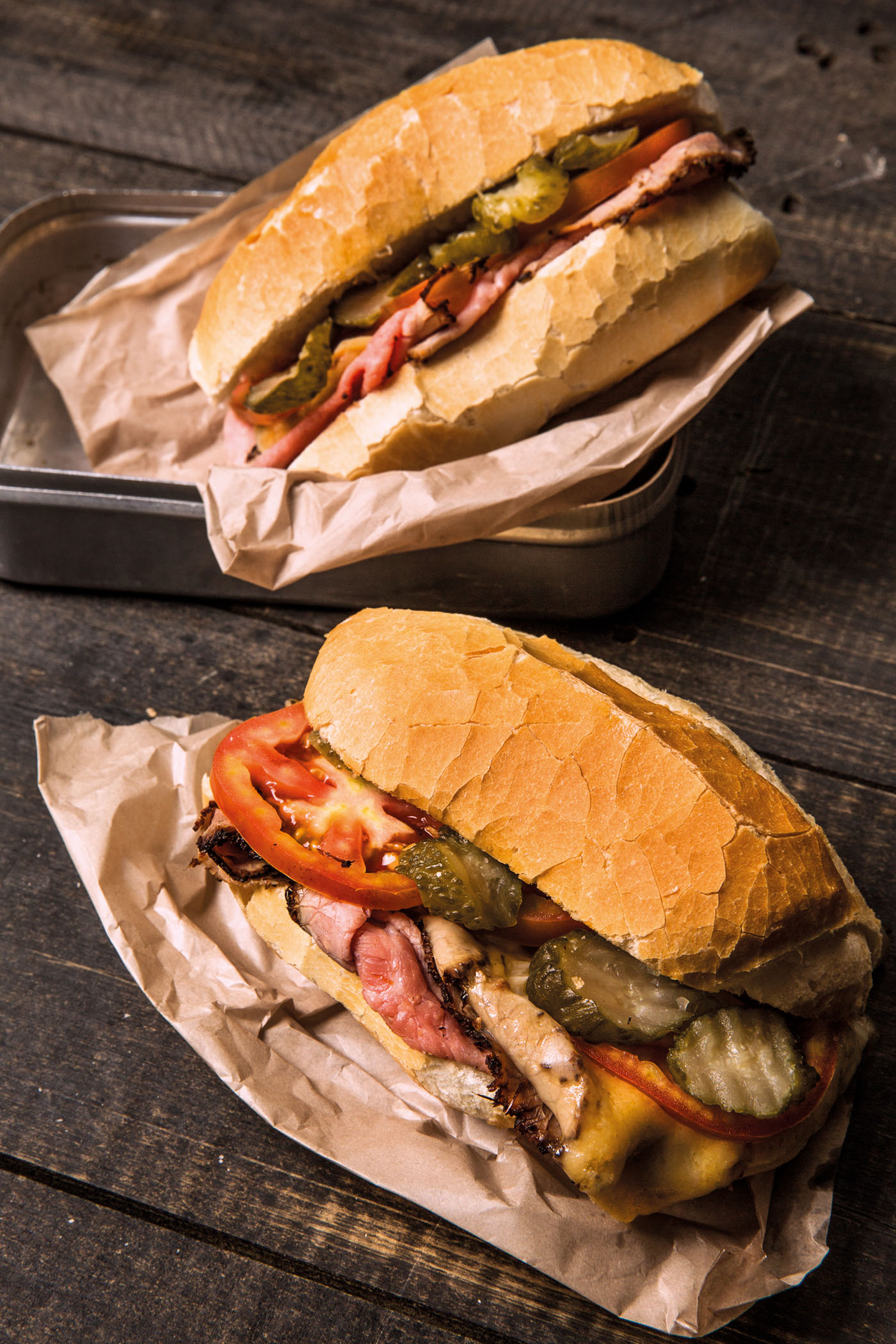
 6 servings
6 servings
 20 minutes
20 minutes
 Easy
Easy
• 6 ROLLS
• 1 YOLK
• 1 TABLESPOON MUSTARD
• 1½ TEACUPS CORN OIL
• JUICE OF ½ LIME
• 720 G ROAST BEEF, FINELY SLICED
• 300 G PRATO CHEESE
• 2 TOMATOES, SLICED
• ½ TEACUP PICKLES
• SALT TO TASTE
Cut the rolls horizontally and set aside. Make the mayonnaise by placing the yolk in a bowl with the mustard and, with a wire beater, whisk the yolk while pouring a continuous strand of oil until it emulsifies, turning into a lighter cream. Add the lime juice and season with salt. Heat up the bread for 2 minutes, spread on the mayonnaise and put in the roast beef. Grill the cheese, just enough so it melts, and put it on top of the roast beef. Put the tomato on the cheese and the pickles on the tomato.
BEIRUT (Beirute)

 6 servings
6 servings
 30 minutes
30 minutes
 Easy
Easy
• 6 LARGE PITA BREADS
• 900 G ROAST BEEF, FINELY SLICED
• 300 G SLICED MOZZARELLA CHEESE
• 1 TABLESPOON DRIED OREGANO
• 1 YOLK
• 1 TABLESPOON MUSTARD
• 1½ TEACUPS CORN OIL
• JUICE OF ½ LIME
• 12 LARGE FLAT LETTUCE LEAVES
• 4 TOMATOES, FINELY SLICED
• SALT TO TASTE
Open the pita bread, dividing it into two pieces. On the bottom part, arrange the roast beef and mozzarella. Sprinkle with oregano and heat on the oven for 5 minutes, until the cheese melts and the meat is warm. For the mayonnaise, mix the yolk with the mustard and beat with a wire whip while adding a continuous tread of oil, until it emulsifies into a light-coloured cream. Add the lime juice and season with salt. Remove the beirut from the oven and spread the mayonnaise on the cheese. Finish off with the lettuce and tomato, cover with the top bread slice, also previously warmed, and serve. In other versions of this sandwich, the roast beef is replaced with tenderloin, chicken fillet, or other type of meat - and there are those who add a fried egg to this recipe.
IN DETAIL
The family of Lebanese immigrant Fares Sader claims the creation of the sandwich – he was one of the founders of Bambi, a restaurant in São Paulo. That's where, in the 50's, the recipe for the sandwich with cheese, za'atar, roast beef, and tomatoes was created in tribute to his homeland. Ham, eggs, lettuce and mayonnaise were filling variations that emerged in diners – not only in São Paulo, but throughout the country.
BURACO QUENTE
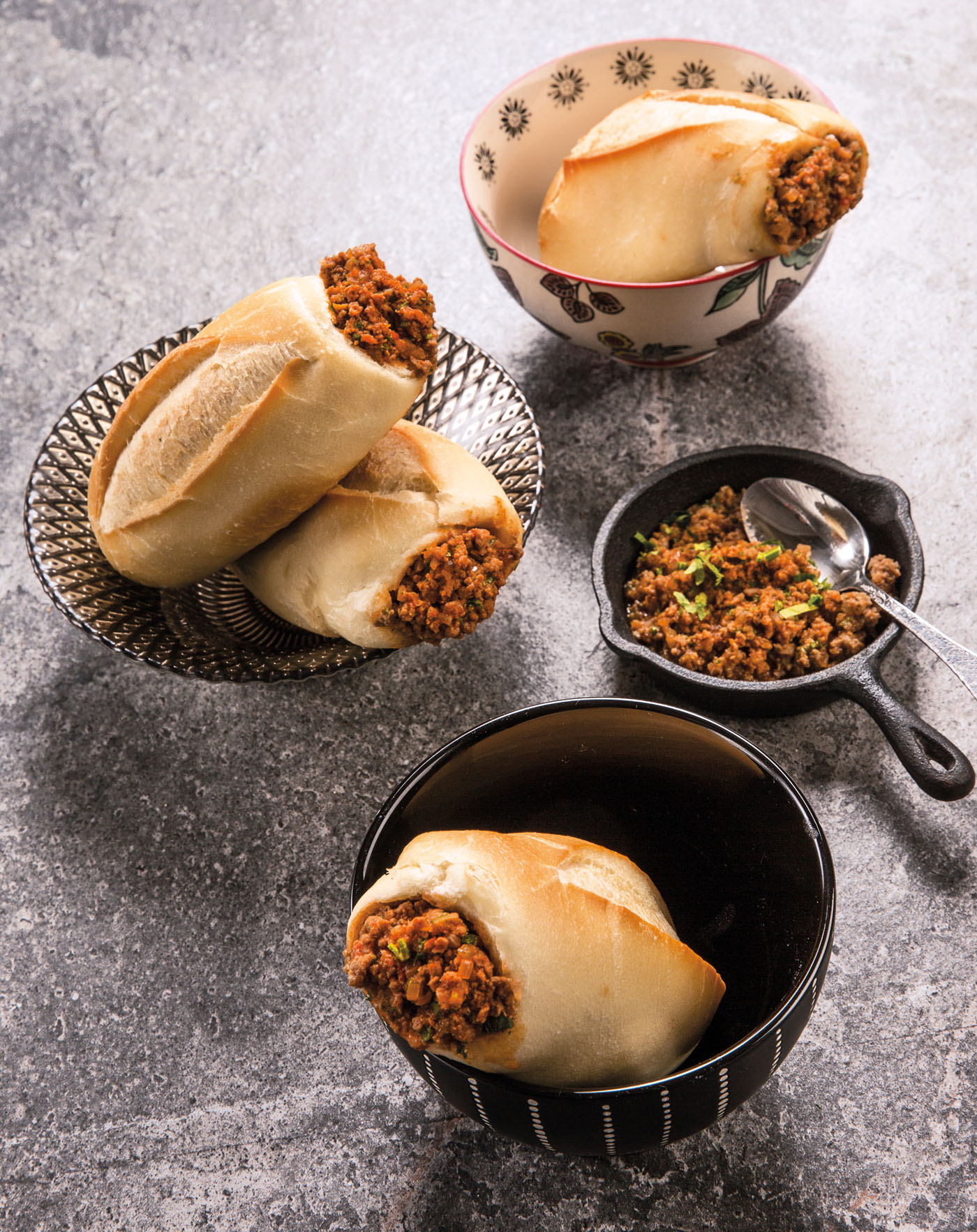
 6 servings
6 servings
 50 minutes
50 minutes
 Easy
Easy
• 700 G GROUND BEEF (KNUCKLE OR INSIDE ROUND)
• 2 TABLESPOONS CORN OIL
• 1 ONION, DICED
• 2 GARLIC CLOVES, MINCED
• 8 PEELED AND DESEEDED TOMATOES, CHOPPED
• ½ BUNCH PARSLEY AND SCALLIONS, CHOPPED
• 6 ROLLS
• PEPPER SAUCE, TO TASTE
• SALT TO TASTE
Braise the ground beef in oil. When it's dry, add the onion and garlic; braise for a bit longer. Put in the tomato and allow it to cook through, until it falls apart and turns into a sauce. Season with salt and a few drops of pepper sauce. Turn off the heat and put in half of the chopped scallions and parsley. Push the crumb to the inside of the bread and stuff with the meat. Sprinkle the remaining herbs and serve.
IN DETAIL
The crispy roll is used as a container for the fillings that vary according to the region. São Paulo and Rio de Janeiro are the birthplace of the most common versions, which are frequent in children's parties and roadside restaurants. In Santos, it's known as "mexicano". In Minas Gerais, "pão de sal com molho".
CHICKEN PIE (Empadão de frango)
 8 servings
8 servings
 1h30
1h30
 Easy
Easy
• 250 G BUTTER AT ROOM TEMPERATURE
• 500 G ALL-PURPOSE FLOUR
• 1 YOLK, FOR BRUSHING
• SALT TO TASTE
FILLING
• 2 CHICKEN BREASTS, COOKED AND SHREDDED
• 2 TABLESPOONS OLIVE OIL
• 1 ONION, DICED
• 2 TOMATOES, CHOPPED
• 3 TABLESPOONS TOMATO SAUCE
• ½ TEACUP HOMEMADE CHICKEN STOCK
• ½ TEACUP OLIVES, CHOPPED
• 200 G COOKED FRESH CORN
• 1 GLASS CREAMY REQUEIJÃO SPREAD
• ½ BUNCH PARSLEY AND ½ BUNCH OF SCALLIONS
Add the butter and all-purpose flour to a bowl and mix with your fingertips until obtaining a moist but crumbly dough. Take pieces of the dough and press them down against the bottom of the baking pan, moulding until it's 1 cm high. Save some dough for the empadão's lid. For the filling, cook the chicken breasts in water and salt, shred them, then set aside. In a pot with olive oil, braise the onion, add the tomato, tomato sauce, and chicken stock. Afterwards, put in the shredded chicken and all the other filling ingredients. Stir thoroughly, pour on the dough and set aside. For the empadão's lid, add ¼ teacup of water to the dough and stir until smooth. Roll out the dough with a rolling pin and shape the lid into a square the same size as the edges of the baking pan. Put it over the filling and, with your fingers, secured the edges of the dough. Brush the yolk on the lid. Bake in a preheated oven at 180°C for 35 to 40 minutes, or until golden.
HEART OF PALM PIE (Empadão de palmito)
 8 servings
8 servings
 1h30
1h30
 Easy
Easy
• 250 G BUTTER AT ROOM TEMPERATURE
• 500 G ALL-PURPOSE FLOUR
• 1 YOLK, FOR BRUSHING
• SALT TO TASTE
FILLING
• ½ ONION, FINELY DICED
• 2 TABLESPOONS OLIVE OIL
• 1 GARLIC CLOVE
• 1½ TEACUPS HOMEMADE VEGETABLE STOCK
• 1 JAR HEART PALMS (LARGE)
• 2 TEASPOONS ALL-PURPOSE FLOUR
• ½ BUNCH PARSLEY AND ½ BUNCH OF SCALLIONS
• 1 DASH NUTMEG
• SALT TO TASTE
Add the butter and all-purpose flour to a bowl and mix with your fingertips until obtaining a moist but crumbly dough. Take pieces of the dough and press them down against the bottom of the baking pan, moulding until it's 1 cm high. Save the remaining dough for the empadão's lid. Braise the onion and garlic in olive oil, add the chopped heart of palm, flour, nutmeg and, lastly, the vegetable stock. Cook over medium heat for 15 minutes. Adjust the salt if necessary, pour over the dough and set aside. For the empadão's lid, add ¼ teacup of water to the dough and stir until smooth. Roll out the dough with a rolling pin and shape the lid into a square the same size as the edges of the baking pan. Put it over the filling and, with your fingers, secured the edges of the dough. Brush the yolk on the lid. Bake in a preheated oven at 180°C for 35 to 40 minutes, or until golden
HAM AND CHEESE ROLLS (Enroladinho de presunto e queijo)
 15 servings
15 servings
 1 hour and 20 minutes
1 hour and 20 minutes
 Medium
Medium
• 1 TEACUP LUKEWARM MILK
• 30 G FRESH ACTIVE YEAST
• 1 TABLESPOON SUGAR
• ½ TEACUP OIL
• 3 EGGS
• 2½ TEACUPS ALL-PURPOSE FLOUR
• 300 G MOZZARELLA (OR PRATO CHEESE, OR COTTAGE CHEESE) FOR THE FILLING
• 300 G HAM, FOR THE FILLING
• 2 TOMATOES, SLICED, FOR THE FILLING
• 1 TEASPOON SALT
• OREGANO TO TASTE
Combine the milk, oil, and yeast, until it dissolves. Add the eggs; slowly put in the flour, then the sugar and, lastly, the salt. Knead thoroughly until the dough is smooth. Cover with a plastic film and allow it to rise until it doubles in size. Divide the dough into pieces, with about 50 g each and, with a rolling pin, roll them out into a rectangular shape with a thin thickness. Arrange a slice of ham, one of cheese, two thin tomato slices, and oregano. While keeping the filling inside the dough, fold it into a pillow-like shape, securing the edges tightly. Allow it to rise for another 15 minutes, covered with plastic film. Bake in a preheated oven at 170°C for about 25 minutes, or until golden.
GRILLED CHEESE AND HAM SANDWICH (Misto quente)

 4 sandwiches
4 sandwiches
 10 minutes
10 minutes
 Easy
Easy
• 8 LOAFS BREAD
• 4 TABLESPOONS SALTED BUTTER AT ROOM TEMPERATURE
• 16 SLICES HAM
• 16 SLICES PRATO CHEESE
Set aside 2 loafs of bread for each sandwich, buttering the up side of the bottom loaf, saving some butter for the outer part as well. Put 2 slices of ham in each sandwich and cover them with 2 slices of prato cheese. Put it in a stovetop sandwich maker and place it over the flame, turning when it's golden. Serve as soon as you remove from the heat.
IN DETAIL
A classic snack found in diners throughout Brazil, it can be made with bread loafs or rolls and served cold or hot. A variation of the French croque monsieur, it can be coated with an egg before grilling or covered with béchamel sauce.
PAN PIZZA (Pizza de panela)

 6 servings
6 servings
 2 hours and 30 minutes
2 hours and 30 minutes
 Medium/Difficult
Medium/Difficult
• 500 G ALL-PURPOSE FLOUR
• ½ TEACUP SUGAR
• 1 TEASPOON SALT
• 1½ TABLESPOONS DRY YEAST
• ¼ TEACUP OLIVE OIL
• 1 TEACUP TOMATO SAUCE
• 2 TEACUPS GRATED MOZZARELLA
• 2 TOMATOES, SLICED
• BASIL
Put the flour on a clean counter and open a hole in the middle. Arrange the dry ingredients in the centre and mix them a bit. Then, add 1 teacup of water and the olive oil, stirring thoroughly until the dough is very smooth. Knead for about 30 minutes, so the dough is very flexible (if you want, you can beat the dough in a beater). Roll the dough into a ball and let it rise for 30 minutes, covered with a damp cloth. Divide the dough into 6 equally-sized balls and allow it to rise for another 45 minutes, or until it doubled in size, covered with a cloth. Spread flour across the counter and roll out the dough until it's about the size of the pan you'll use. Heat up a pan, put in the dough, spread the sauce over it, top it with mozzarella and close the lid. Allow the pizza to grill and the cheese to melt, taking care not to burn the bottom part. When the pizza's dough is cooked through and the cheese has melted, put the tomato slices and basil leaves. Serve right away. You can use whichever flavours you'd like for the topping.
CALABRESA SAUSAGE AND VINAIGRETTE SANDWICH (Sanduíche de calabresa com vinagrete)
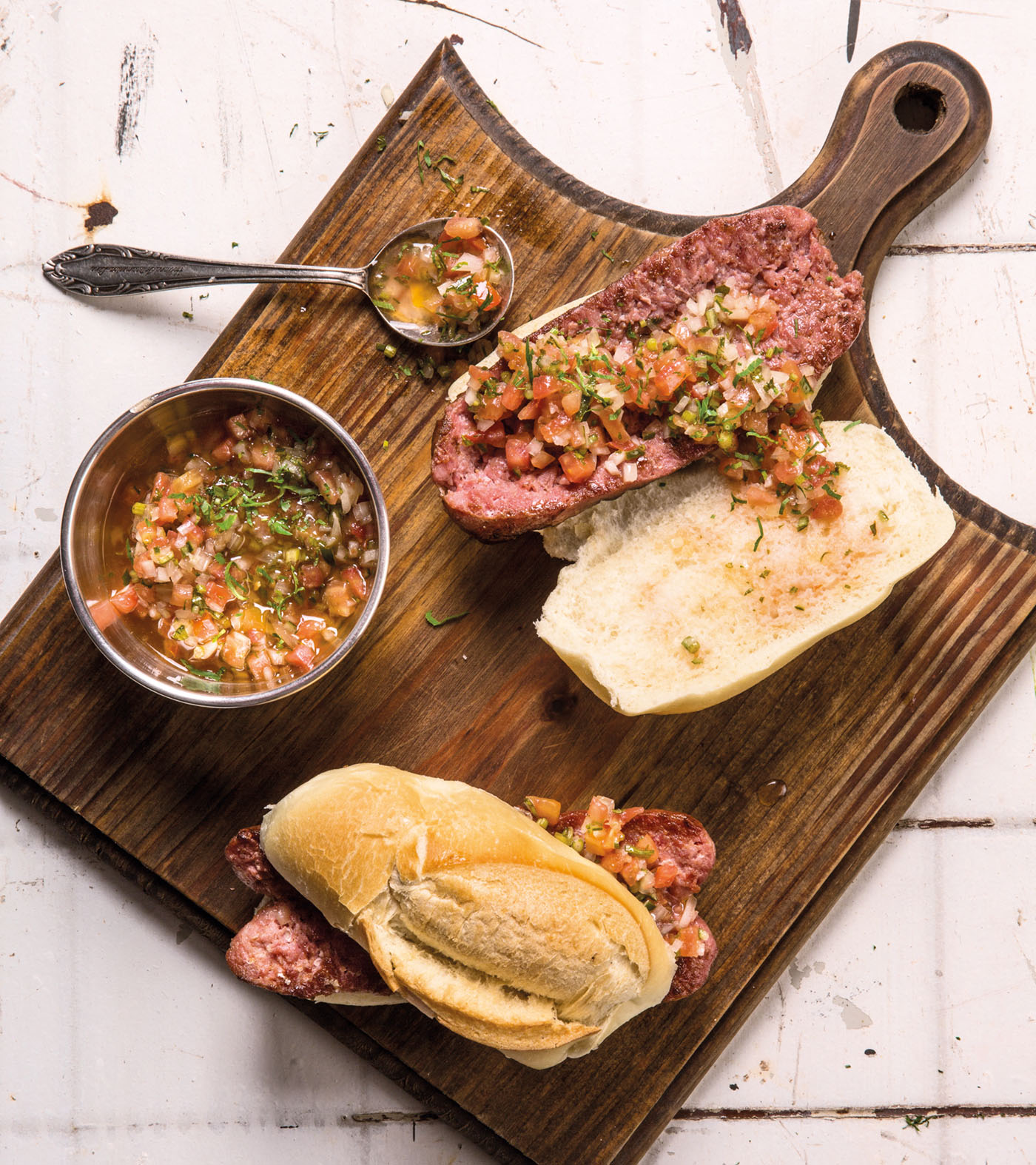
 4 servings
4 servings
 20 minutes
20 minutes
 Easy
Easy
• 1 CALABRESA SAUSAGE 500 G
• 2 TABLESPOONS CORN OIL
• 4 PEELED, DESEEDED TOMATOES, DICED
• ¼ ONION, DICED
• 1 TABLESPOON CHOPPED CORIANDER
• 1 TABLESPOON THINLY SLICED GREEN ONIONS
• 1 TABLESPOON CHOPPED PARSLEY
• ⅓ TEACUP OLIVE OIL
• 1 TABLESPOON LIME JUICE OR VINEGAR
• 4 ROLLS
• SALT AND BLACK PEPPER TO TASTE
Quarter the calabresa and sear each side in hot oil. Meanwhile, prepare the vinaigrette by mixing the tomato, onions, greens, olive oil, lime juice, salt, and black pepper. Cut the sausage pieces in half and fry their middle section until cooked through. Cut the bread in half, warm it, and fill it with the sausage and the vinaigrette. If you want to, top it off with homemade mayonnaise.
BARBECUE AND CHEESE SANDWICH (Sanduíche de churrasquinho com queijo)
 4 servings
4 servings
 15 minutes
15 minutes
 Easy
Easy
• 4 TENDERLOIN OR STRIPLOIN STEAKS WITH 150 G EACH
• 4 PEELED, DESEEDED TOMATOES, DICED
• ¼ ONION, DICED
• 1 TABLESPOON CHOPPED CORIANDER
• 1 TABLESPOON THINLY SLICED SCALLIONS
• 1 TABLESPOON CHOPPED PARSLEY
• ⅓ TEACUP OLIVE OIL
• 1 TABLESPOON LIME JUICE OR VINEGAR
• 1 TABLESPOON CORN OIL
• 12 SLICES PRATO CHEESE
• 4 ROLLS
• SALT AND BLACK PEPPER TO TASTE
Pound the steaks, so they are a bit thinner, and season with salt and black pepper. Prepare the vinaigrette: mix the tomato, onions, greens, olive oil, lime juice, salt, and black pepper. Heat up the oil and brown the meat on both sides. Cover with the prato cheese, put on the lid and wait until it melts. Warm the rolls, put in the steaks, and top it off with the vinaigrette.
MORTADELLA SANDWICH (Sanduíche de mortadela)

 1 sandwich
1 sandwich
 5 minutes
5 minutes
 Easy
Easy
• 1 ROLL
• MORTADELLA SLICES, TO TASTE
Open the bread and arrange the mortadella slices. If you wish, you can heat it on a griddle.
PORK SHANK SANDWICH (Sanduíche de pernil)

 8 servings
8 servings
 2 hours and 30 minutes, plus time to marinate
2 hours and 30 minutes, plus time to marinate
 Medium
Medium
• 500 G BONED FRESH PORK SHANK
FOR THE MARINADE
• ¼ LARGE ONION
• ¼ LARGE CARROT
• 1 CELERY STALK
• ¼ LEEK STALK
• 1 GARLIC CLOVE
• ½ DEDO-DE-MOÇA PEPPER, DESEEDED
• 1 TEACUP WHITE WINE
• 1 BAY LEAF
FOR THE SAUCE
• ¼ ONION, CUT INTO STRIPS
• ¼ RED BELL PEPPER, PEELED AND CUT INTO STRIPS
• 8 ROLLS
• SALT AND BLACK PEPPER TO TASTE
Prepare the pork shank with the marinade ingredients following the recipe of fresh ham – allow it to marinate for 3 hours and roast for 2 hours. With the gravy of the roast that was left of the bottom of the baking dish, braise the onions and bell pepper until soft. Slice the ham finely, put the slices in the preheated roll and finish off with the sauce.
MANIOC STARCH CREPES (Tapioca)
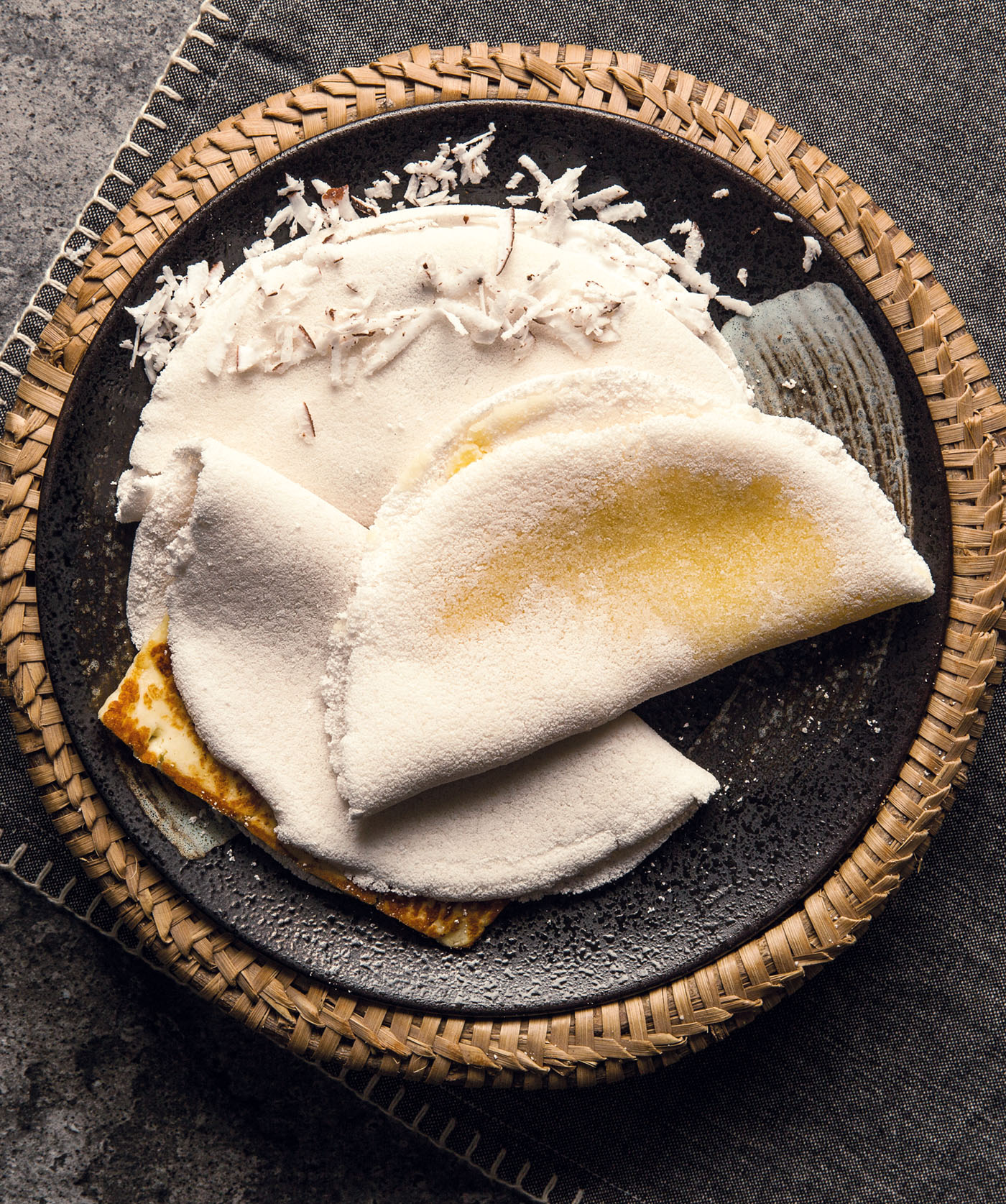
 6 units
6 units
 30 minutes
30 minutes
 Medium
Medium
• 500 G DE POLVILHO DOCE
• SAL A GOSTO
• 500 G MANIOC STARCH
• SALT TO TASTE
Put the manioc starch in a bowl, season with salt, and slowly pour in 332 ml of water while mixing with your hands. The manioc starch will become dull and slightly puffed up. Using a sieve, sprinkle the starch directly onto an iron skillet, creating a layer that shouldn't be too thin, or else it will crack. Cook over high heat for about 30 seconds. Turn and cook for another 15 seconds. Now you can butter it up and eat it. For the filling, you can also mix fresh coconut milk with grated coconut and a bit of condensed milk, or fill it with a slice of grilled coalho cheese.
IN DETAIL
This type of crepe made with manioc starch is also known as beiju. It's an iconic breakfast food and snack throughout Brazil, a habit that was handed down directly from indigenous peoples. The consistency, thickness and fillings can vary.
SARDINE PIE (Torta de sardinha)
 1 rectangular pie
1 rectangular pie
 2 hours
2 hours
 Medium
Medium
• 2 TABLESPOONS OLIVE OIL
• ½ MEDIUM ONION, DICED
• 2 GARLIC CLOVES, MINCED
• 3 DESEEDED TOMATOES, CHOPPED
• 500 G FRESH, CLEAN SARDINES
• ½ BUNCH PARSLEY, CHOPPED
• SALT AND BLACK PEPPER TO TASTE
FOR THE DOUGH
• 1 TEACUP MILK
• 1 TEACUP CORN OIL
• 3 EGGS
• 2 TEACUPS ALL-PURPOSE FLOUR, PLUS A BIT EXTRA FOR SPRINKLING
• 1 TEASPOON SALT
• 1 TEASPOON BAKING POWDER
• BUTTER, FOR GREASING
Heat the olive oil and braise the onion with the garlic and tomatoes. Add the sardines, parsley, and a dash of water. Put on the lid and cook until the sardines begin to fall apart. Season with salt and black pepper; set aside. In a blender, combine all of ingredients for the dough, except the baking powder. Mix until smooth. Add the baking powder and stir. Grease a baking tray with butter, sprinkle it with flour and layer half of the dough, the filling, and the remaining dough. Bake in a preheated oven at 180°C for 30 minutes, or until golden.
TUCUMÃ AND CHEESE SANDWICH (X-caboquinho)
 1 serving
1 serving
 10 minutes
10 minutes
 Easy
Easy
• 1 ROLL
• ½ TABLESPOON BUTTER
• 2 SLICES COALHO CHEESE
• 1 TUCUMÃ, CUT INTO FLAKES
Toast the buttered bread and heat the coalho cheese until it's slightly melted. Ensemble the sandwich with the tucumã and the cheese. If you wish to, you can add a vertically sliced banana-pacova fried in a bit of butter.
IN DETAIL
The tucumã is an Amazonian fruit that is used as the filling for this typical Northern delicacy. Served in a roll and accompanied by coalho cheese – often also garnished with French fries and eggs – it's a nourishing sandwich eaten between meals.
CHICKEN HEART SANDWICH (X-gaúcho)
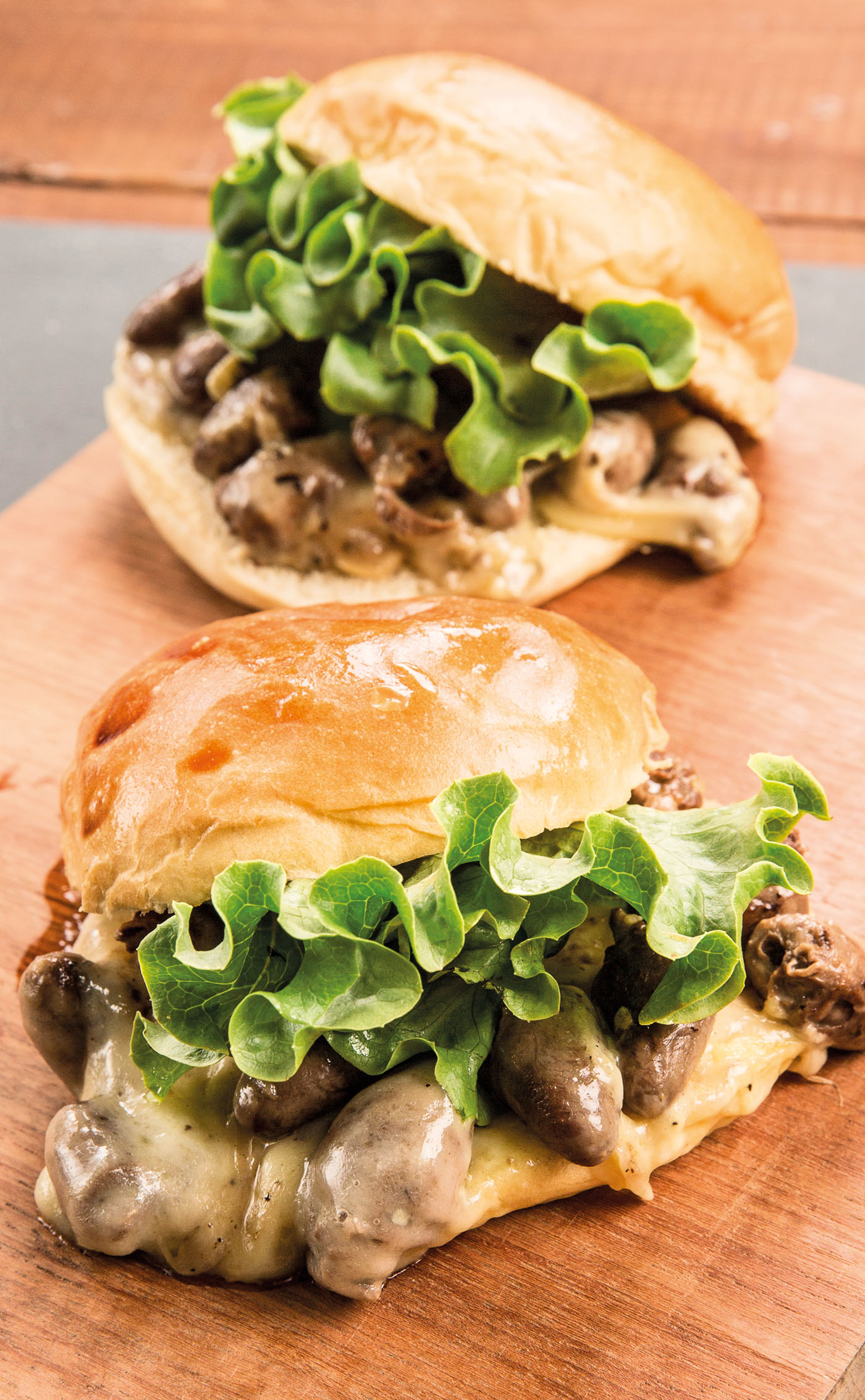
 4 servings
4 servings
 20 minutes
20 minutes
 Easy
Easy
• 2 TEACUPS CHICKEN HEARTS
• 1 TABLESPOON CORN OIL
• 8 PRATO CHEESE SLICES
• 4 LARGE HAMBURGER BUNS
• 1 TEACUP MAYONNAISE
• 4 LARGE LETTUCE LEAVES
• 1 TEACUP BOILED CORN
• 1 TEACUP FRESH, BOILED PEAS
• 2 PEELED AND DESEEDED TOMATOES, CHOPPED
• SALT AND BLACK PEPPER TO TASTE
Season the hearts with salt and black pepper. Heat up the olive oil and grill the meat quickly, so it won't be chewy. Cover with cheese, put on the lid and wait for it to melt. Cut the bums in half, spread out the mayonnaise, arrange the lettuce, corn, peas, and tomatoes. Fill with the chicken heart and serve.
IN DETAIL
The "X", as it is affectionately called by natives of Rio Grande do Sul, is as versatile as all sandwiches made on the grill. The classic version uses chicken hearts, besides the conventional hamburger bun. New versions were created and it began to appear in the menus of diners, which now invest in huge versions that serve up to 4 people, supplemented with bacon, tenderloin, and sausages, among other ingredients.